PAINTING WITHOUT PAINT
EXERCISE 1.3. Exploring unconventional painting materials
Video to be watched about Rashid Johnson and his choice of materials to paint with.
I was at first interested in his use of floor material and taking it to the wall – using a burning tool he created marks and gestures onto the surface. The use of soap and shea butter is a personal choice mostly due to its relationship to cultural memories, colonialism, consumerism? On the Culture Trips website, I found an interview between the artist and F Barnes (May 2017), and here he talks about his own heritage (African) as being too far detached from him that he likes to explore this as an attempt to understand himself better. He calls his relationship with Africa ‘fictional’, as he has been born in the West, and feels most connected to the African diaspora and that is what he tries to explore in his work. I found in most of my research that Shea butter is connected to West Africa and is seen as very valuable due to its medicinal and cleaning abilities. I see it as a shield in his work – a story about protection, but also a story about knowing and not knowing and or being and not being – if you were from West Africa you will know the history, if you are not from West Africa, the artists is here to share the history through his work – it could bring conversations about culture and difference.
“My work provides a platform, a set of signifiers and ideas that exist in my thinking, in my history, and in my negotiation of the world.”
Rashid Johnson
I do like that the artist connects his viewers with this material by using it, thus creating a conversation around materials artists use as well as questioning and testing the potential of artmaking in this moment and time.Later I managed to buy it and consider exploring with in terms of making art during this project development. It made me think how he would liquefy the soap and wax to pour onto his surfaces – is it in a way like encaustic would work? I have never worked with wax or heated materials. I found an article where Johson discuss a little how he works with the soap and wax. (https://www.studiointernational.com/index.php/rashid-johnson-magic-numbers-afrocentrism-new-black-yoga) Here actions like pour, walk, full-body movements, scratching, digging in, window of time, mark-making, performance comes into his making. Below is a question that was asked, as well as his reaction:
Q: Are you proprietary about your materials, about authorship?
RJ: The generation I grew up with always had this feeling of authorship, of authoring a space, and that included materials that you can call your own and no one else can use without referencing you. It’s: “Here’s my stamp, here’s my language, here’s my sense of place.”
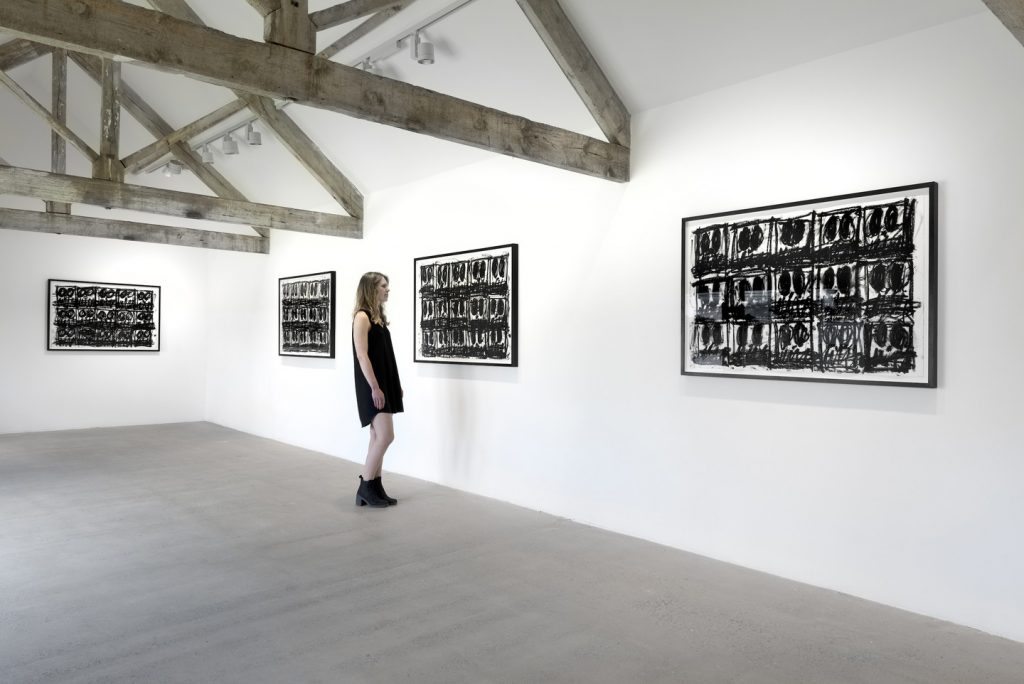
I read the following in an interview between the artist and F Barnes (Culture Trip): “In my use of the materials and the assumption of how those materials function. So for instance, shea butter is a material that is used in cooking, it’s used as a product for healing and for skincare, so it’s got this really wide-ranging employability. So when I use it, I talk about healing, and I talk about the idea of the application of Africanness to the body. If you’re in Africa you’re not considering applying an Africanness to your body, you’re just using the tools that are near to you. So my kind of projection onto that material is exoticising and creating a narrative that is exclusive for people from my location.”
Method
Make a list of materials I can investigate:
- tea/coffee
- spice like turmeric, curry
- leaves of plants and tree bark
- roots of plants as a drawing/painting machine
- mushroom spoor
- mushroom ink
- beetroot juice
- sea weeds and other sea grasses
- soil
- dust/fluff collected from tumble dryer (laundry)
- nail varnish
- glue or wax
- charcoal powder
- oxides that colour cement or plaster of Paris
- Clay
- bodily excretions (saliva, urine)
- paint with hair
- soap – different types investigate
- cyanotyping on canvas or paper
- digital painting
My first attempt was drawing with Pink coloured nail varnish and then I covered/smeared over it with a clear wax shoe polish. I let it dry in the sun and then added hair shampoo – my ‘grey’ hair type, which is purple and added some Acrylic flow medium to it – I moved a wide brush through some of the paint to create some forms and then sprayed it with water and let it dry.
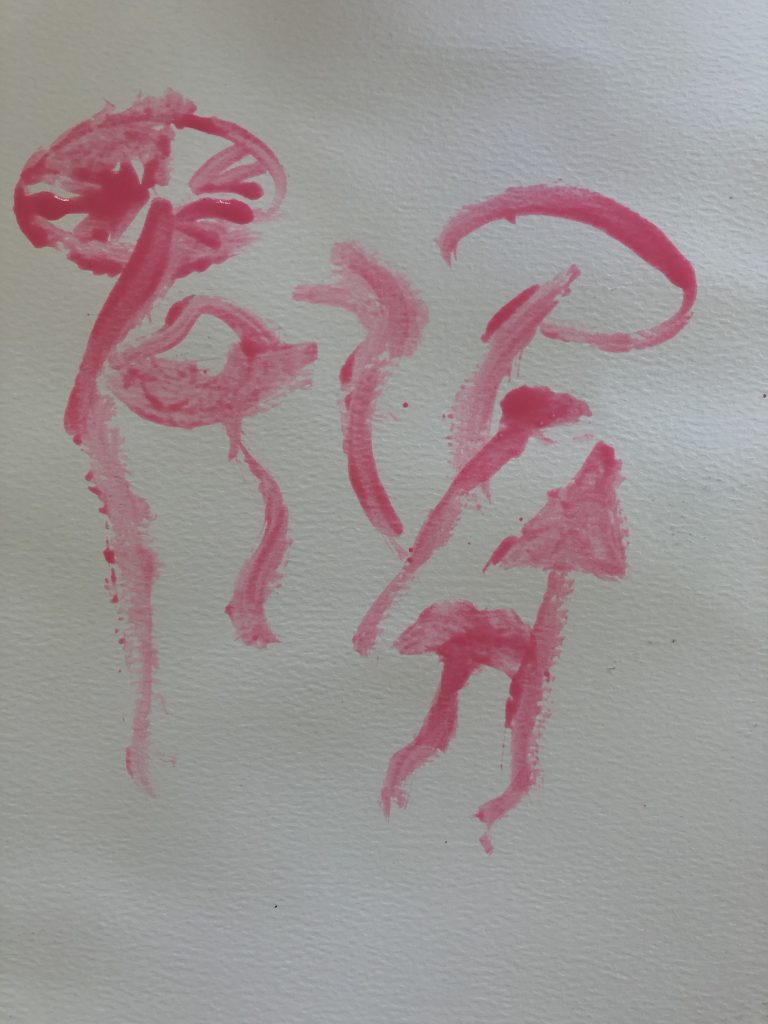
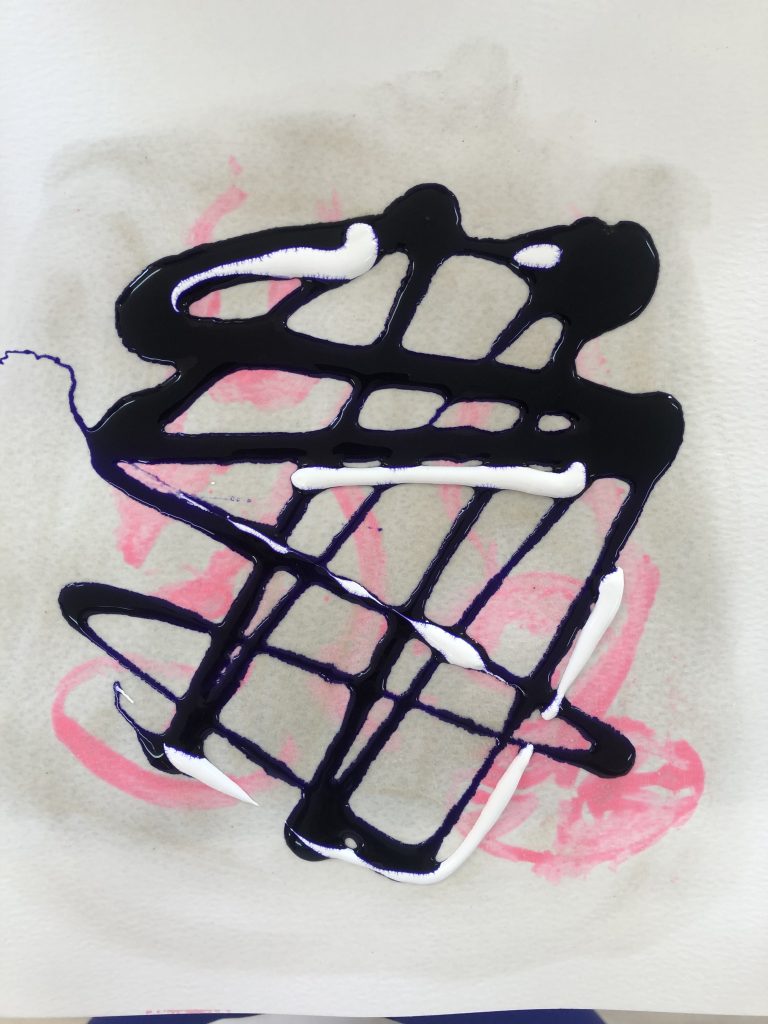

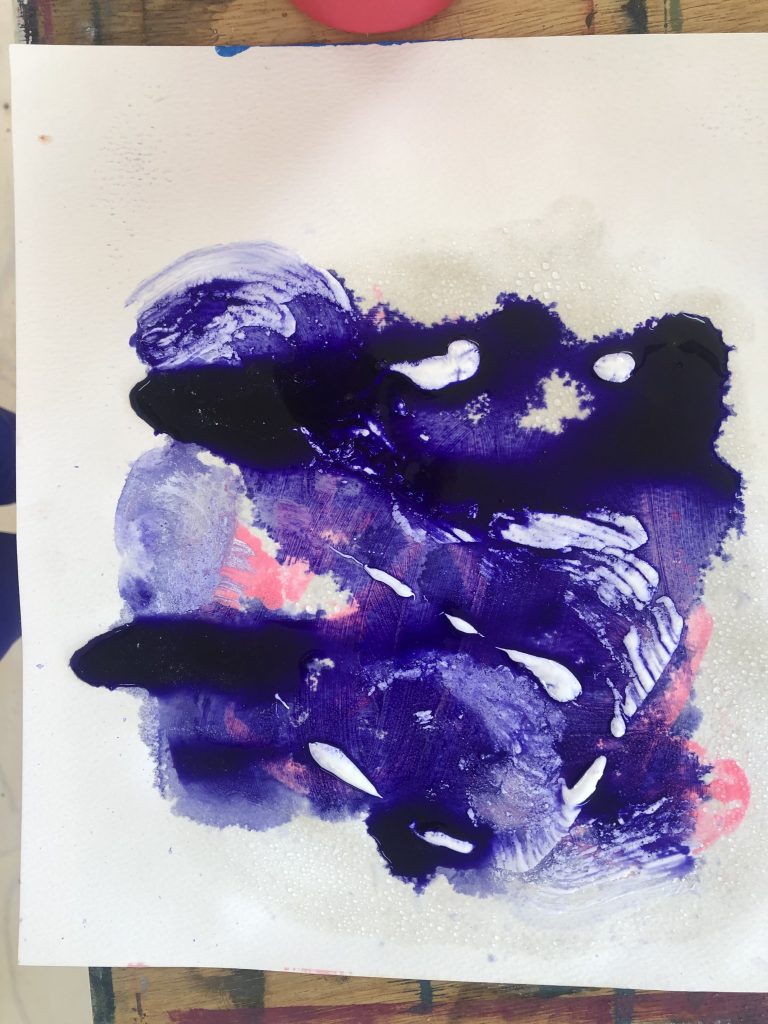
As this work developed over the morning, I sprayed some water on the medium and the colors started to flow. I used Velum paper to make an imprint and liked that print of the materials that stuck onto the Velum. I continued with these imprints and made three more prints from the Velum and original ‘painting’. The layers of the materials/medium became less evident in these works.
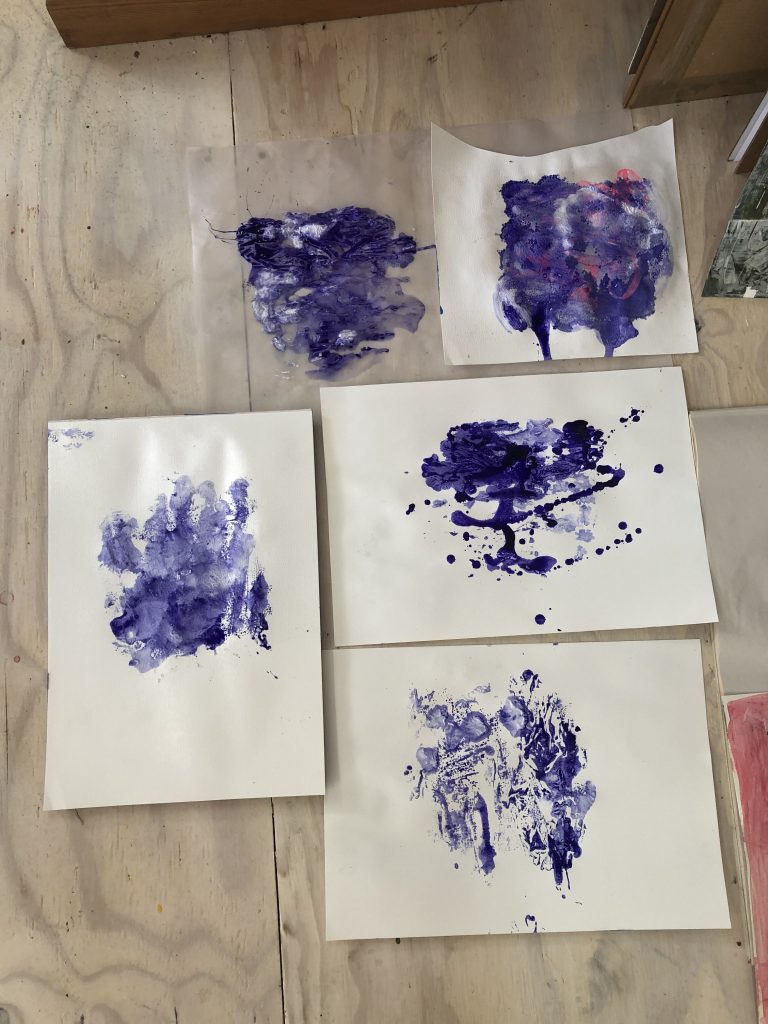
I scratched onto the first (original attempt) work and loved the flow of the residue of the wax/hair shampoo as I drew with a thin stick into the surface. The work has a very nice aroma to it and feels soft. I cannot help but think of Cy Twombly and his works where he used mark-making and gestures to such an almost effortless extent. The work reminds me of how memories can be erased and has a feel of temporality about it. I can see the possibilities of an upscaled work and would like to explore it. I can even see this type of presentation as part of my Fungi Collaboration and eventual online exhibition.
After a week or so the texture of the materials are still soft and the aroma is still close to the original material – hair shampoo. I can still scratch into the surface of the material. I feel the learning is that within this process of making and exploring I was shaping my thoughts about form and this is an ongoing process as soon as I connect with the work surface. I would like to consider the rest of this series – I see possibilities of developing this for my work for my Parallel project.
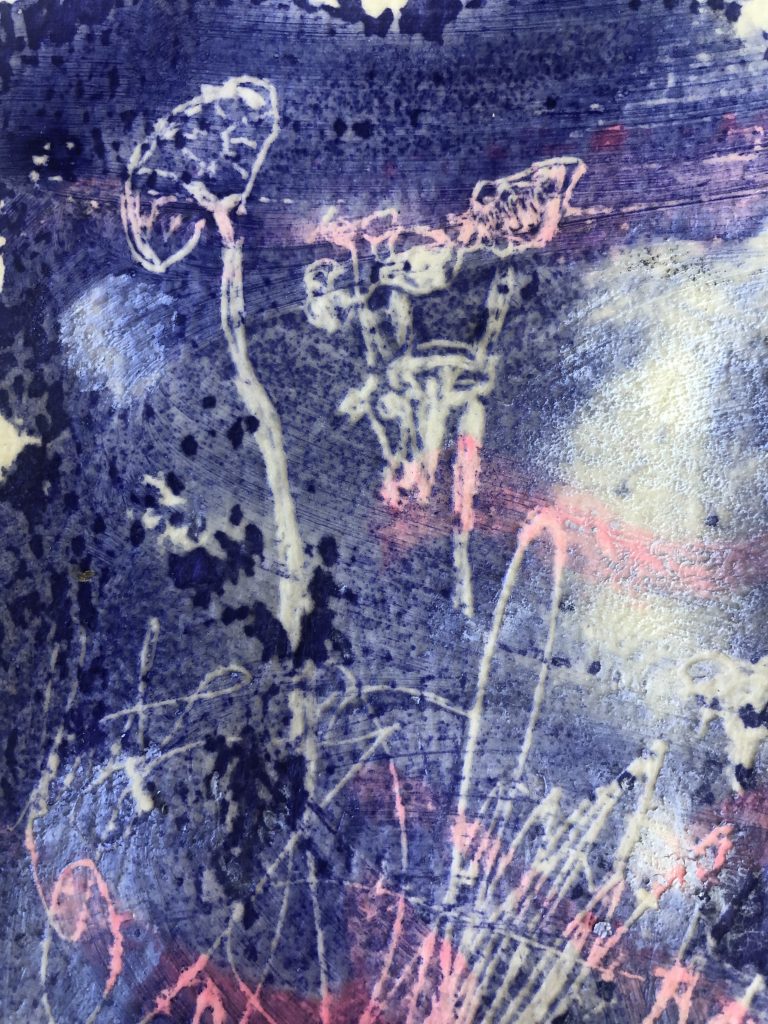
The artist who paints with her hair, below in Image 7: Amy Sillman in a video discussion (2020: 11:59/1:22)talks about painting and using the principal of accidents or “chance operations” as a “series of adjustments, moods, awkwardness…accidental meeting of systems and certainty”. I like the idea of the work in that the whole body is used as a tool, but it is a very vulnerable position, even though one could say it resembles an everyday activity (mopping a floor) By doing the performance the artist eventually claims the space – the canvas, which is the floor space. Below G Rasmussen (Danish/Filipino birth) performs her work. I wondered if the blue canvas hanging on the floor was also done by her, but with blue ink? I later read that she has done a work where she used her body to paint within an attempt to look at hybridization (2020): By smearing her body with ink derived from squids and transferring the ink on silk the artist becomes one with the animal and thereby turning into a hybrid herself. The animation of the squid becomes an animation of how society expects humans to be: flexible and constantly adapting to our surroundings – like an octopus. Comments on her work are that it appears both abstract and minimalistic but also complex in its multitude of layers.
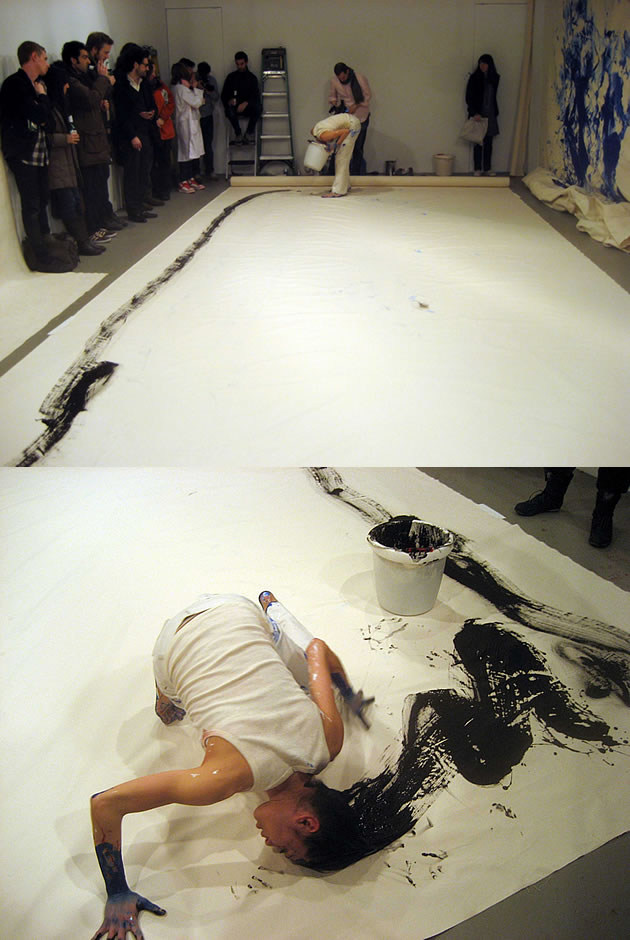
Lilibeth Cuenca Rasmussen is a Danish video performance artist, here the painting take on a performance quality: great sweeping actions as hair is dipped in ink; her whole body a painting tool. This work is an interpretation of Janine Antoni’s ‘Loving Care’ done in 1993. In Loving Care, Antoni mopped the floor of the gallery with her hair soaked in Loving Care hair dye “Natural Black.” The artist’s actions conjured up the expressive marks of Abstract Expressionist painting, linking them to the chore of mopping. As she claimed the space, the audience was slowly backed out of the gallery.
Using an object to paint with, like the Japanese method of printing, called Gyotaku A natural object like a fish below, is smeared with ink, covered with a sheet of paper and then rubbed until the image has been transferred. This results in prints such as the gyotaku fish print above. This technique could be used to transfer surface textures and patterns to an artwork, as well as (when appropriate) to add actual images of relevant natural objects to an artwork. The idea that a fish is used in this way, is a bit strange, because was that fish killed only for the use of its skin? I can see it as part of recording a type/species of fish, like for research? Later I read that sumi ink would be applied to one side of a freshly caught fish. Then the fish would be covered with rice paper and rub to create an exact image of the fish. The ink was non-toxic and allowed for the fish to be processed for eating while preserving records of fish species and sizes. (Smithsonian)
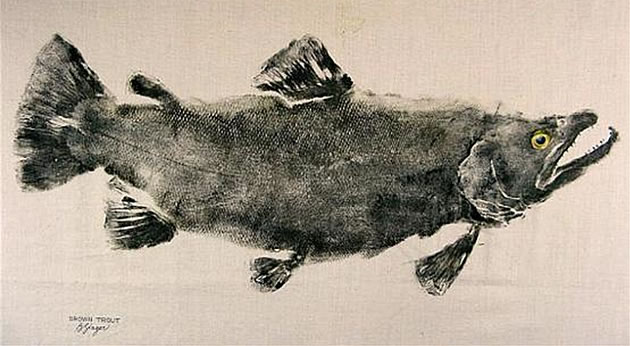
I looked at mushroom spore
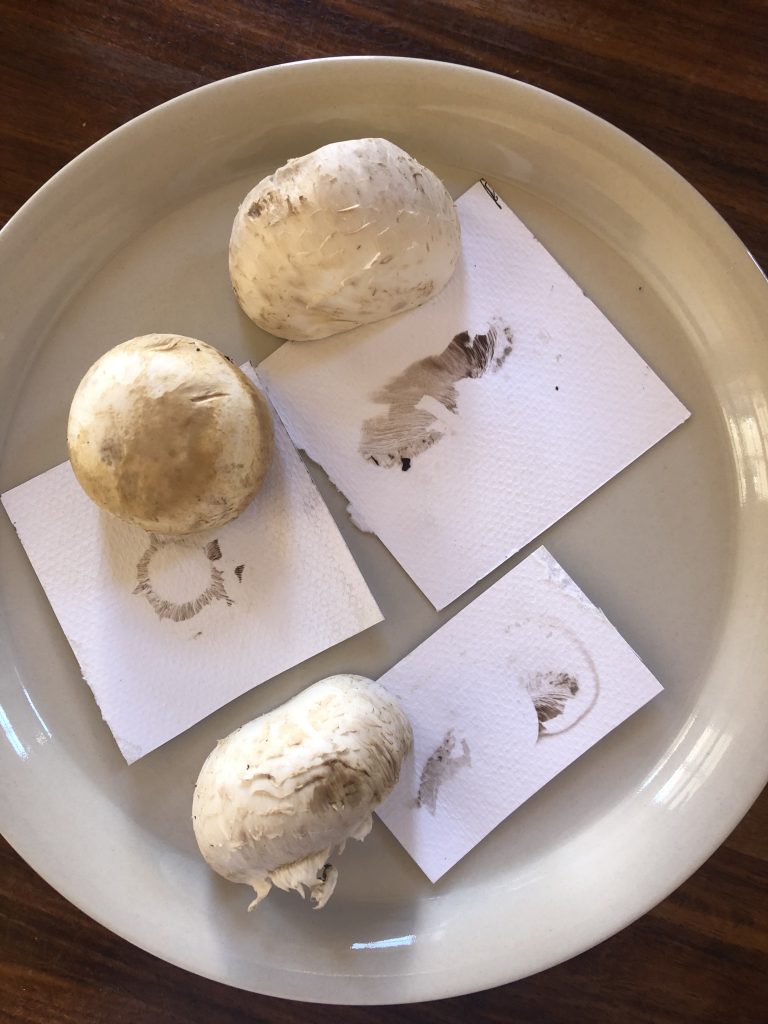


I also used a tomato from the veggie patch outside my studio and tried to paint with it, mixed it with varnish and blue acrylic paint and later added some garden soil to and turmeric to it – it was lying outside to dry.
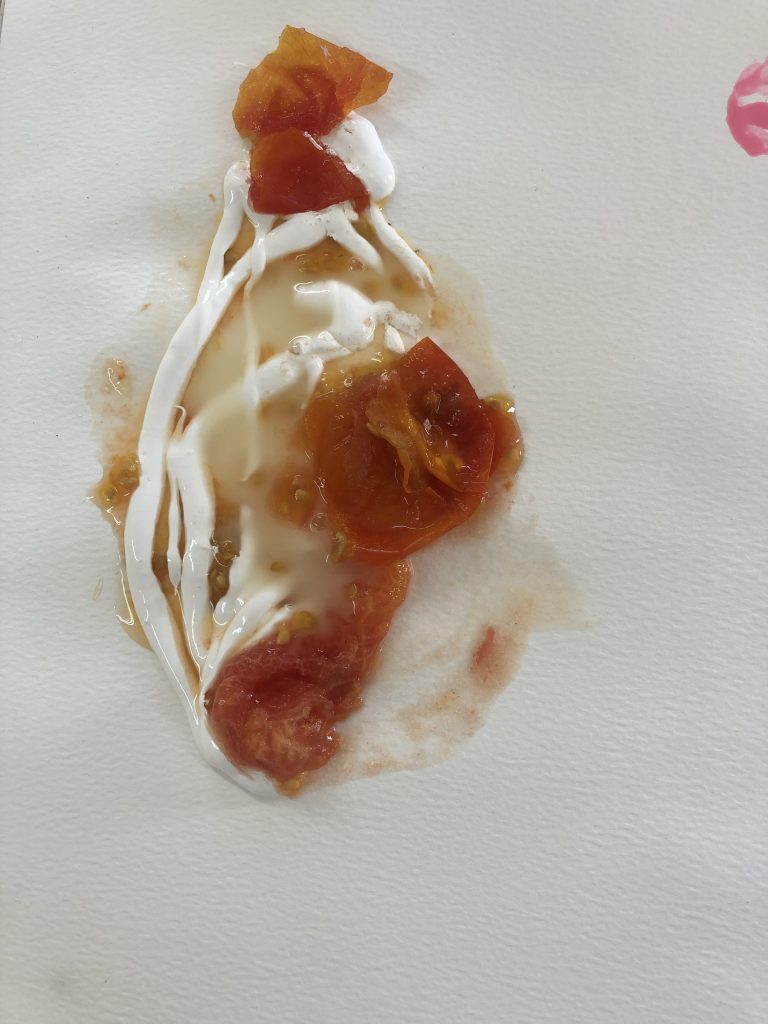
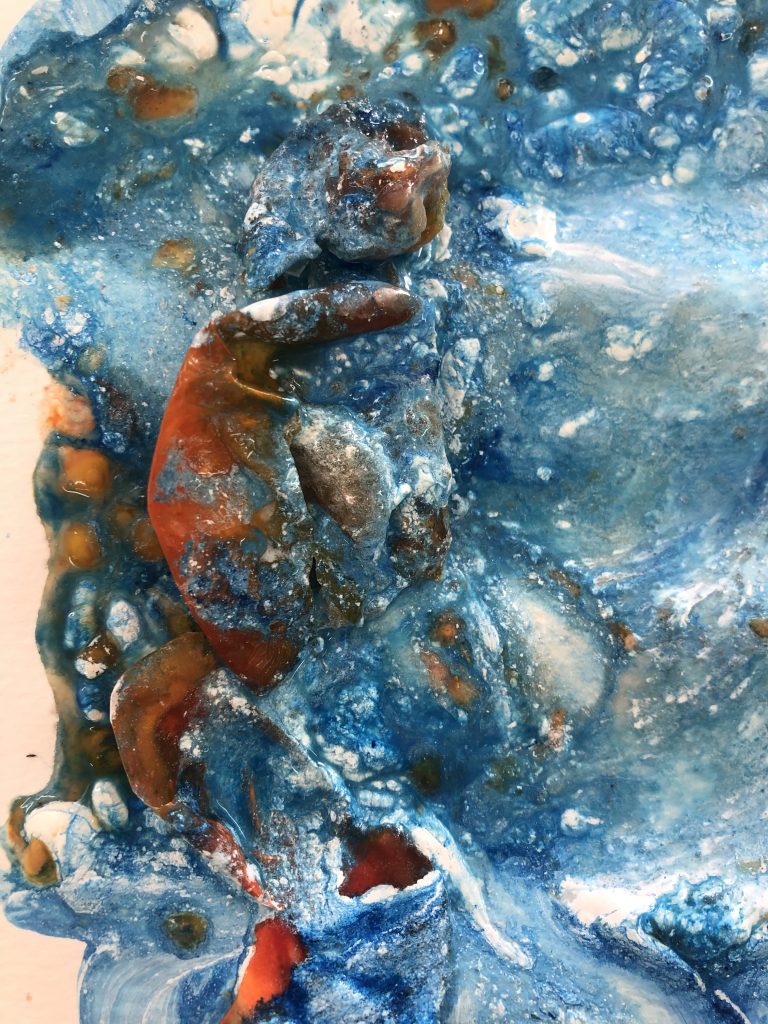
I painted a skull on watercolour paper with beetroot sap and added a layer of coffee.
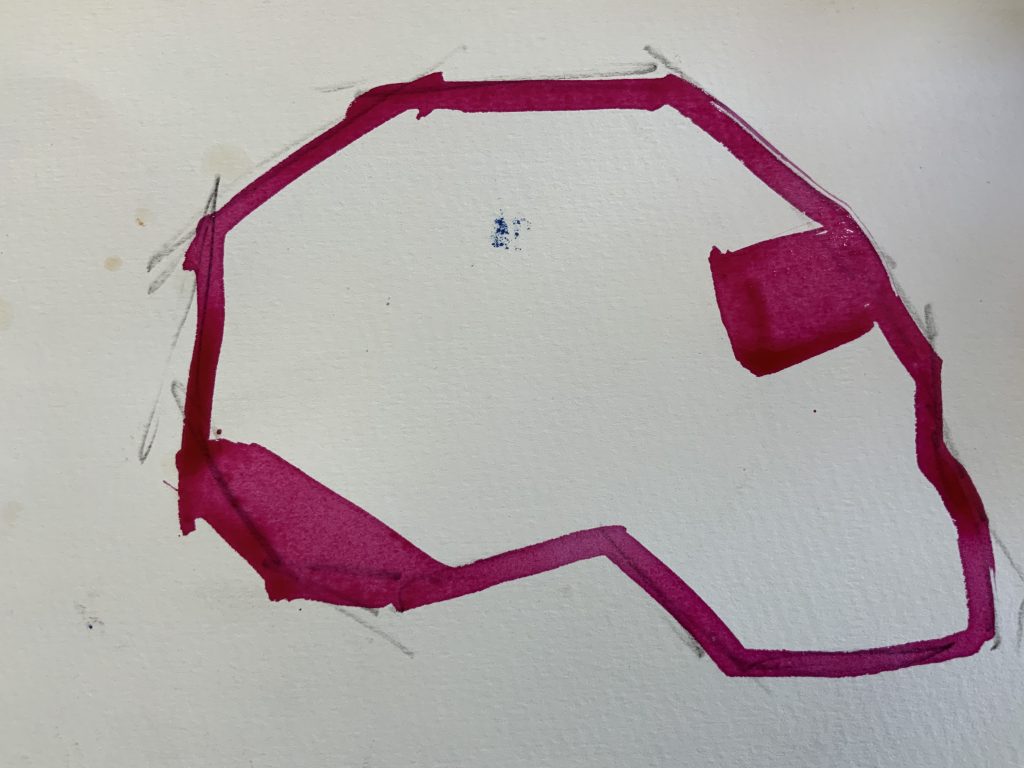
I used shoe wax as the first layer and then dusted charcoal powder onto it. I could ‘write’ with a sharp stick into it and made movements resembling mycelium or networks onto it. I feel this surface has a different surface with tones on it and working into it has many options. I really enjoyed making this work and explored the materials further in my Parallel Project.

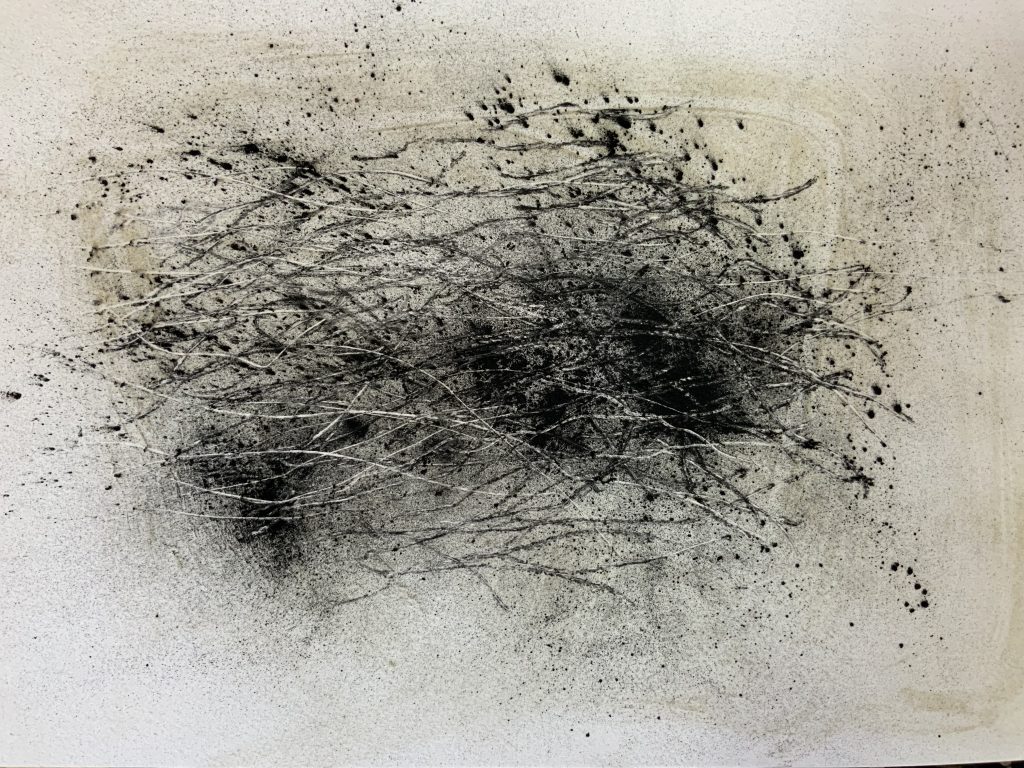
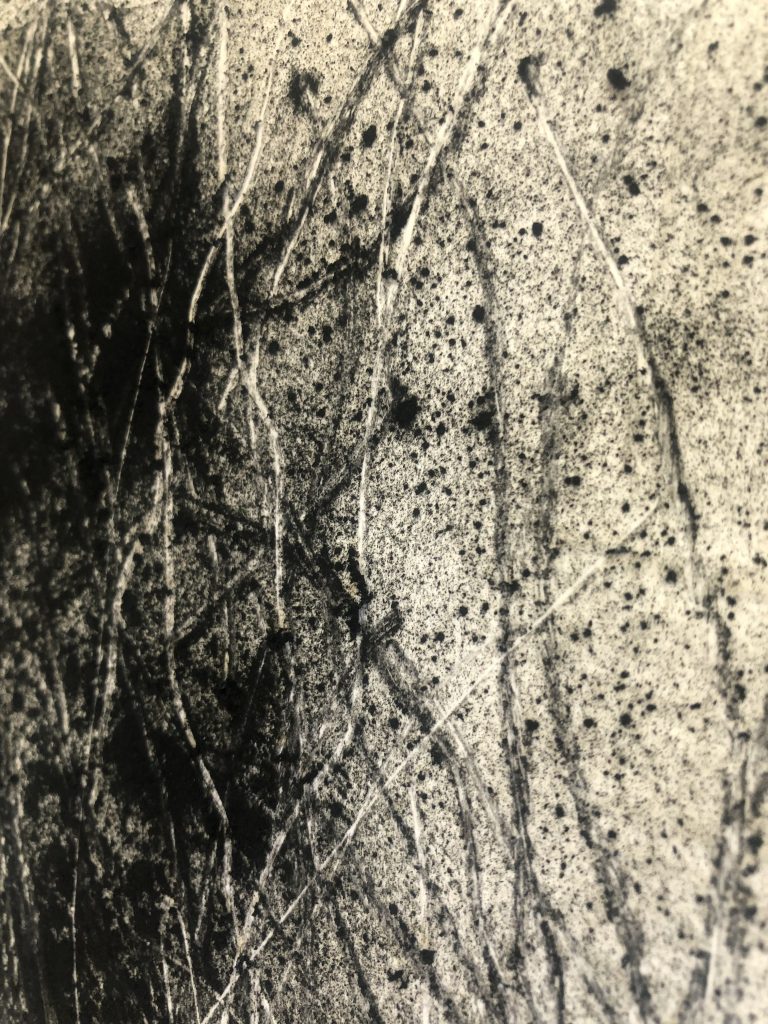

This making inspired me to make a charcoal and pastel drawing of a sunflower as they are now quickly drying in the veggie patch in front of my studio. I tried to add some ground turmeric into the mix, but apart from a lovely aroma, it did not really stick to the surface to show its presence as a colour in my very limited palette.
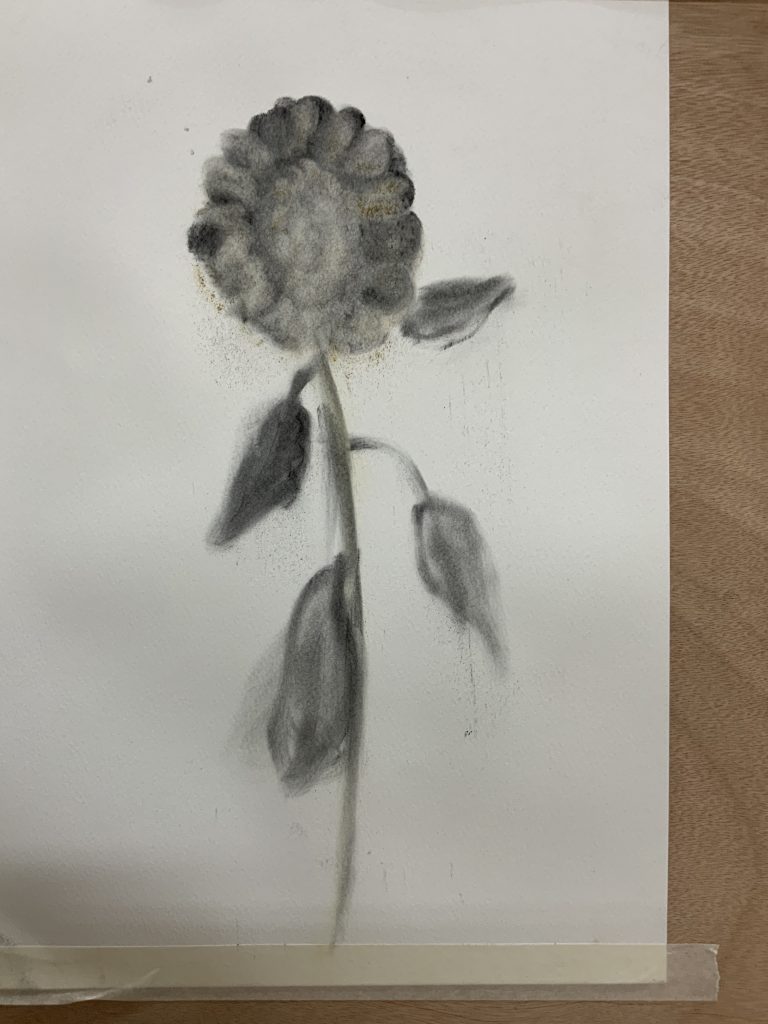
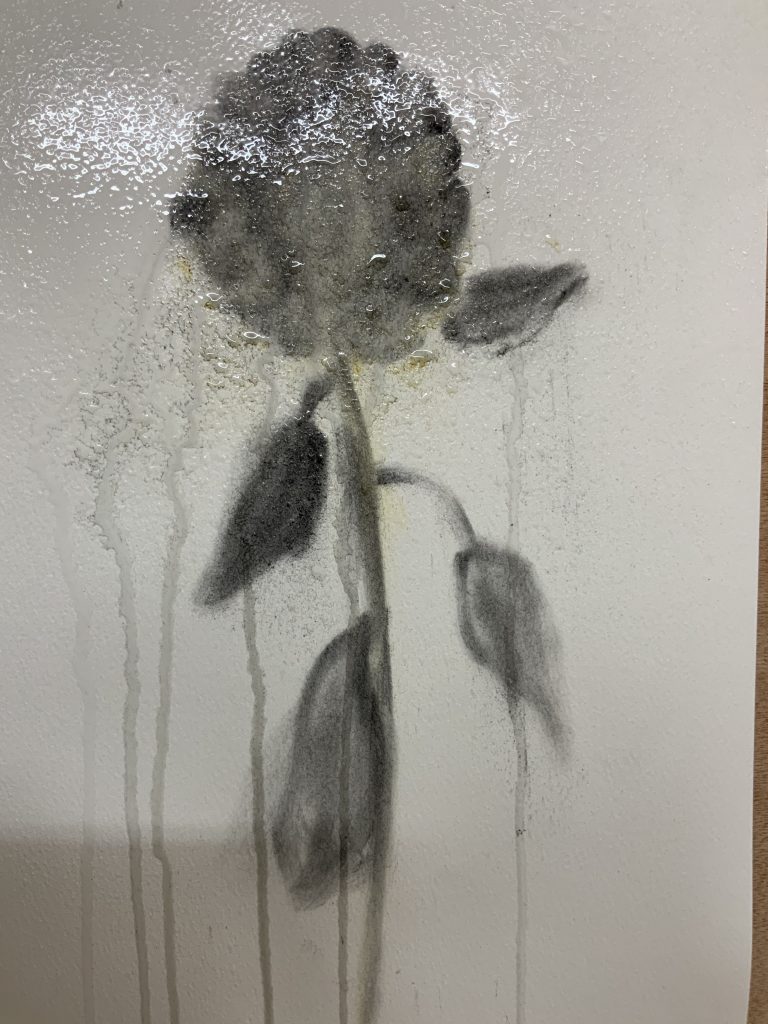
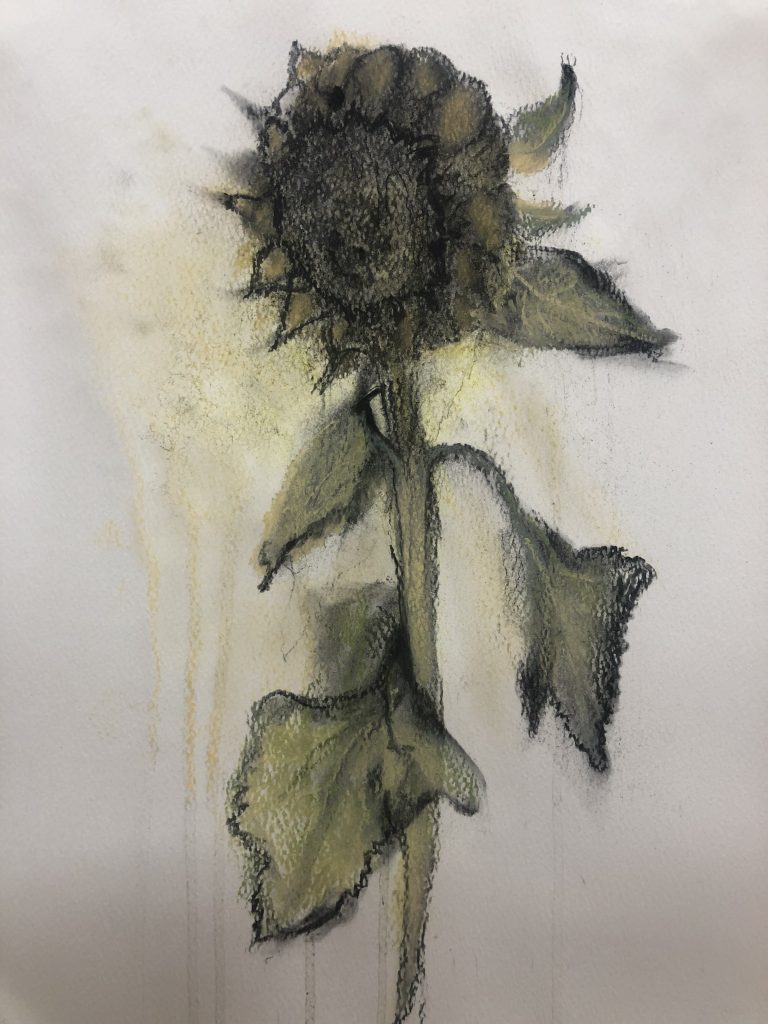
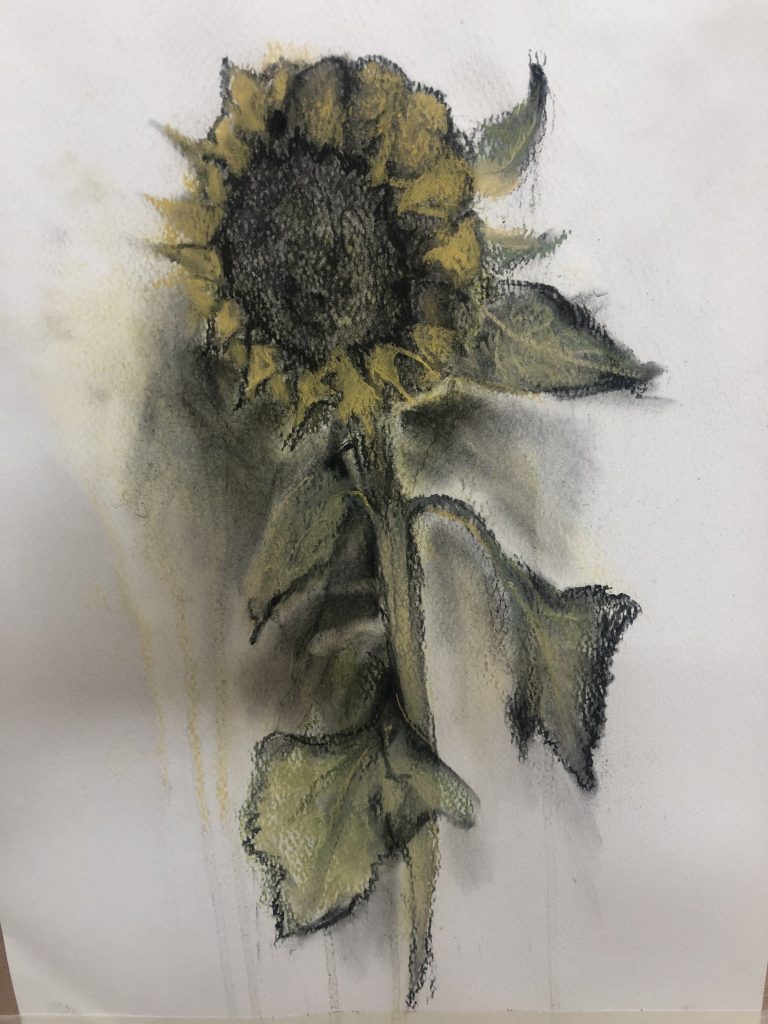
I considered other pigments I could use to paint with. I had a packet of Yellow Oxide which the builders used for colouring cement, which I know is compatible with plaster of Paris as well.
My thoughts also went to explore a form of collage: I had a prepared canvas, added liquid medium, fluff from the tumble dryer and then added ink – I let the painting make itself and think the skin as texture onto the canvas represents something feminine and explorative.
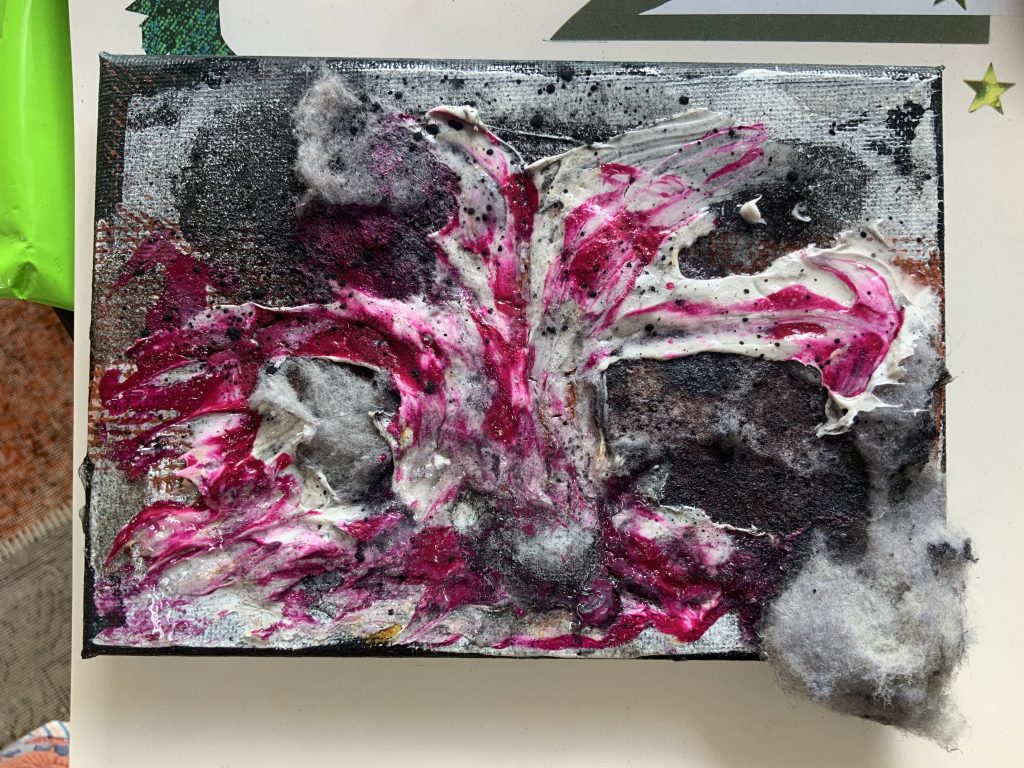
Beetroot sap was applied on some of the objects I have made and it applies really well to the plaster of Paris as well as to the Tile cement object. in the objects below. I think as a colour this is a natural dye and works well as paint onto paper as well as other objects as shown in the works below.
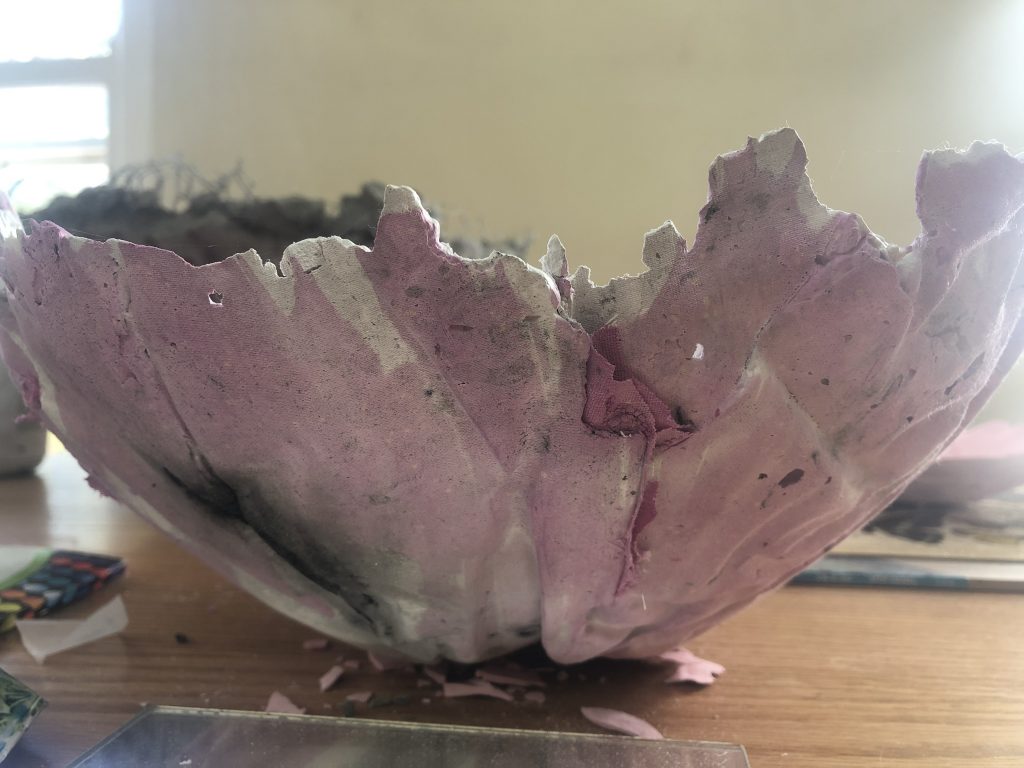
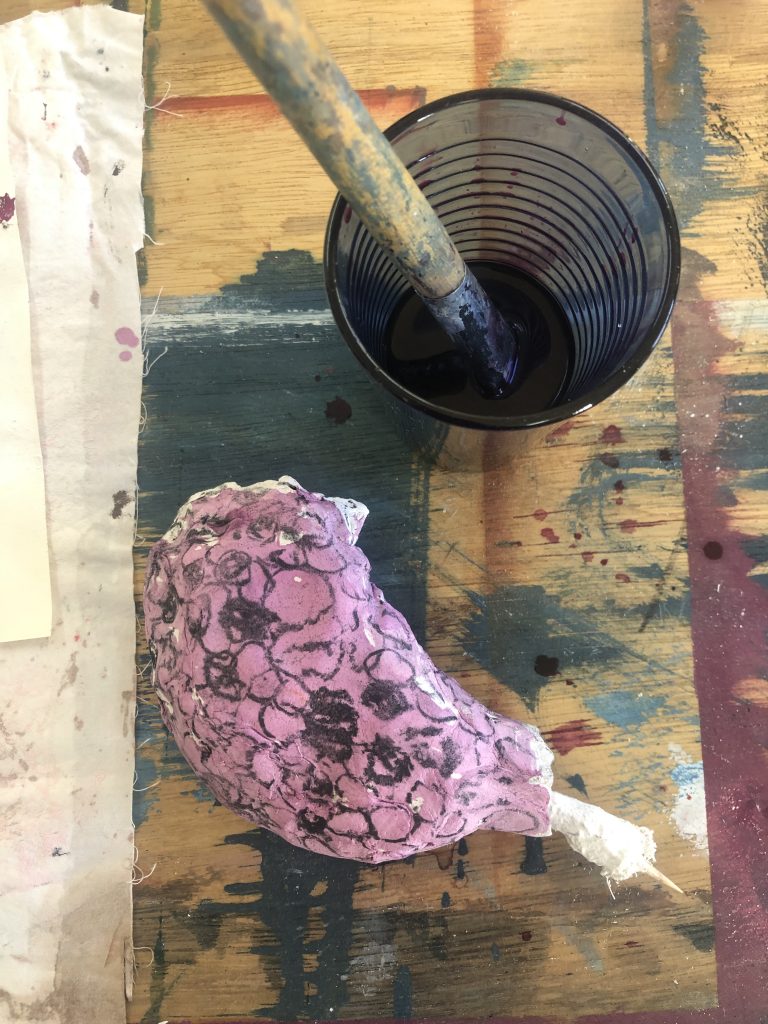
I looked at combining more dry materials with adhesive materials onto a canvas and then charcoal onto it. I decided to work with my fungi explorations and made small fungi drawings onto Canson fine sanded card for Pastel (355g/m’)
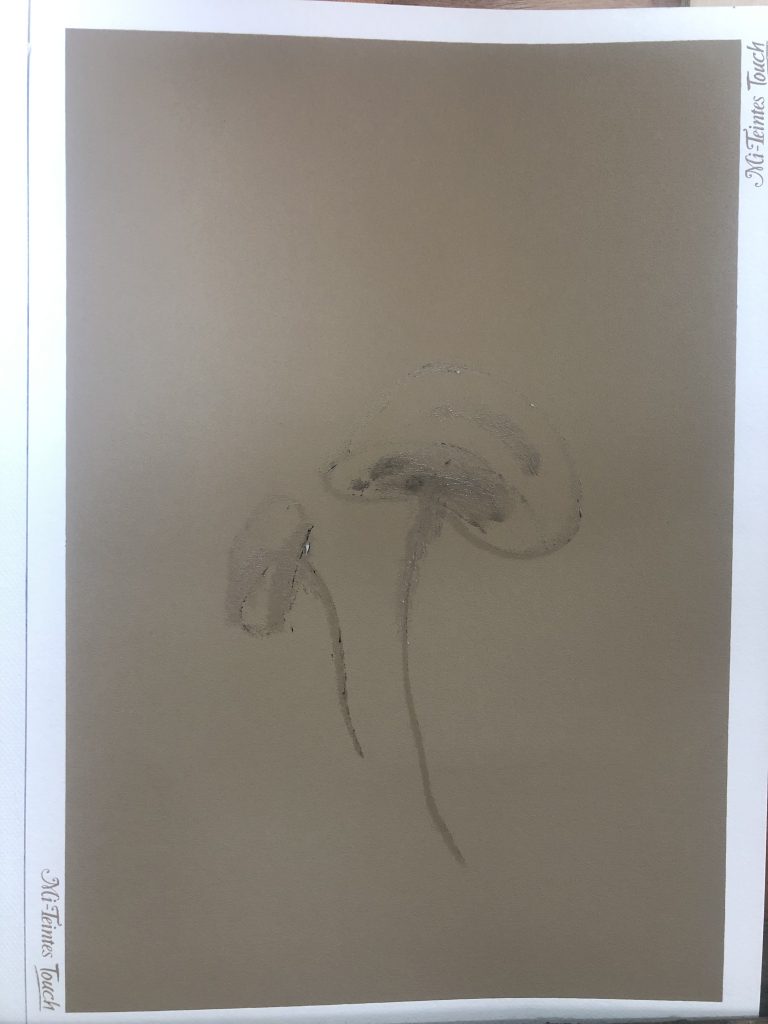
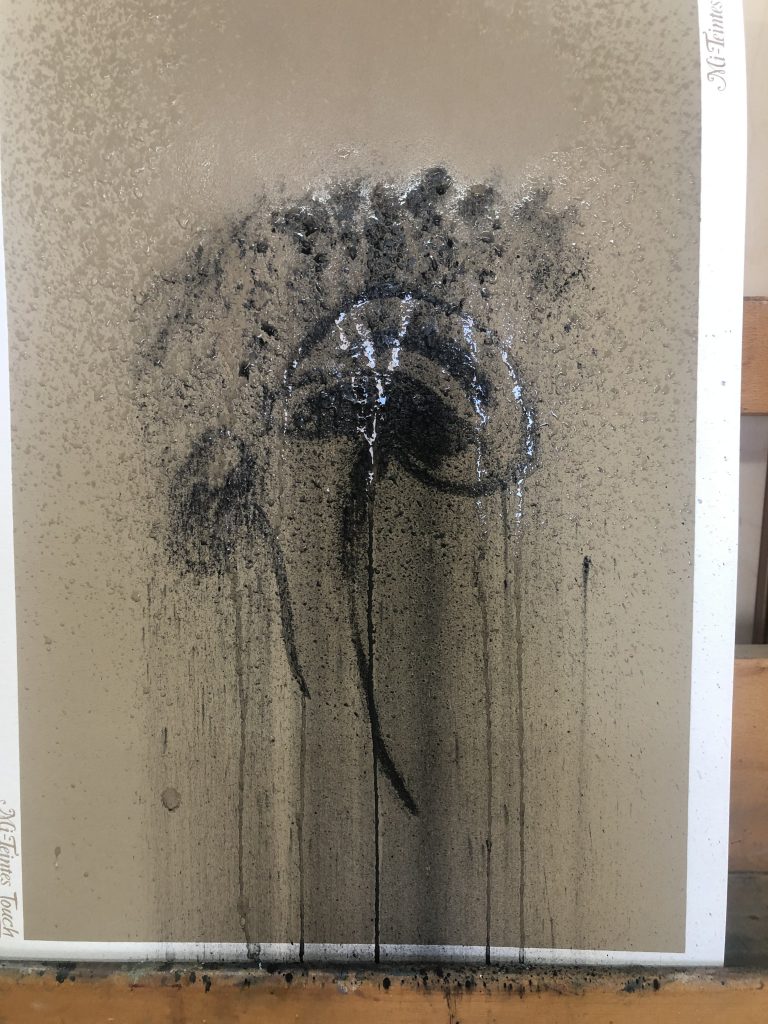
I remember being on a camping holiday and not having water at hand when was painting with watercolours – I opted to use my own saliva to wet and mix the dry watercolour blocks. (funny part was that my kids also wanted to contribute) I cannot help but think if they came up with the idea of using urine. Later I read about an incident where Paul Klee mentions in his diary that an artist friend once was not able to find water on the streets of Rome to do a painting, so he used his urine. (Widewalls, Anapur, 2016)
For the next work I used a metallic paint I have had for quite a while, it is a DecoArt product and the colour is bronze antique. I read that it is acrylic paint and made from finely ground metal flakes.
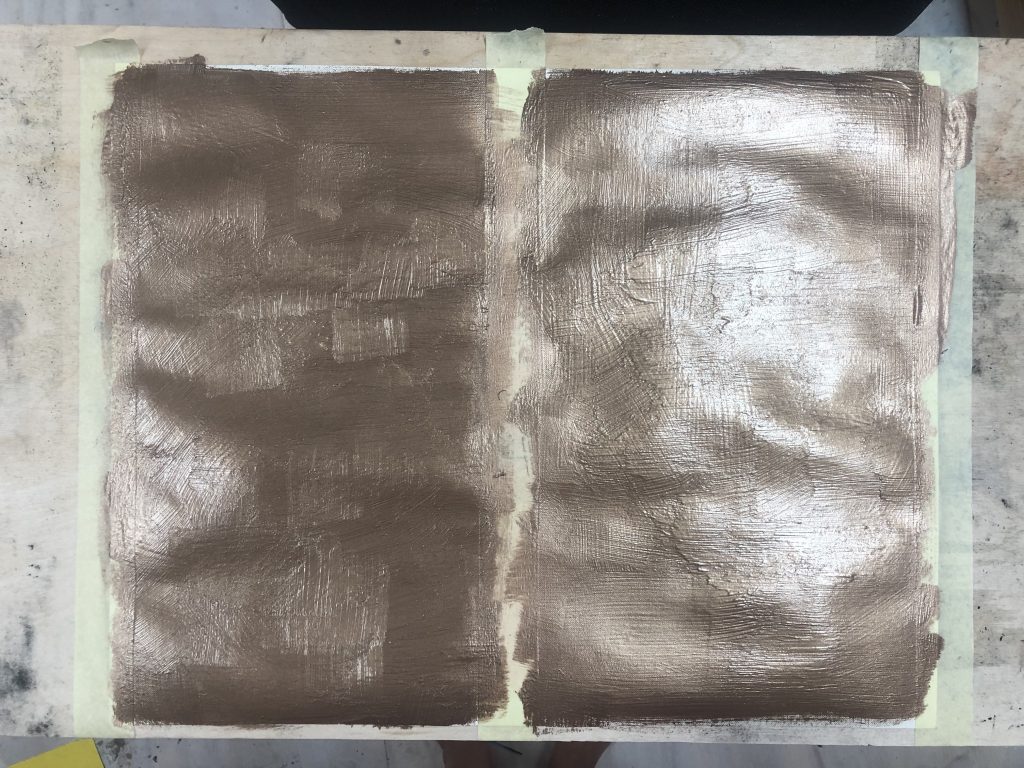
I paint two layers of this paint onto a canvas sheet, which I divide into two, to consider using different materials. I tried vinegar and vinegar mixed with salt. I worked wet into wet, but it seemed the paint would just move, but no colour reaction that could indicate visually that the vinegar mixtures oxidated on the metal surface.

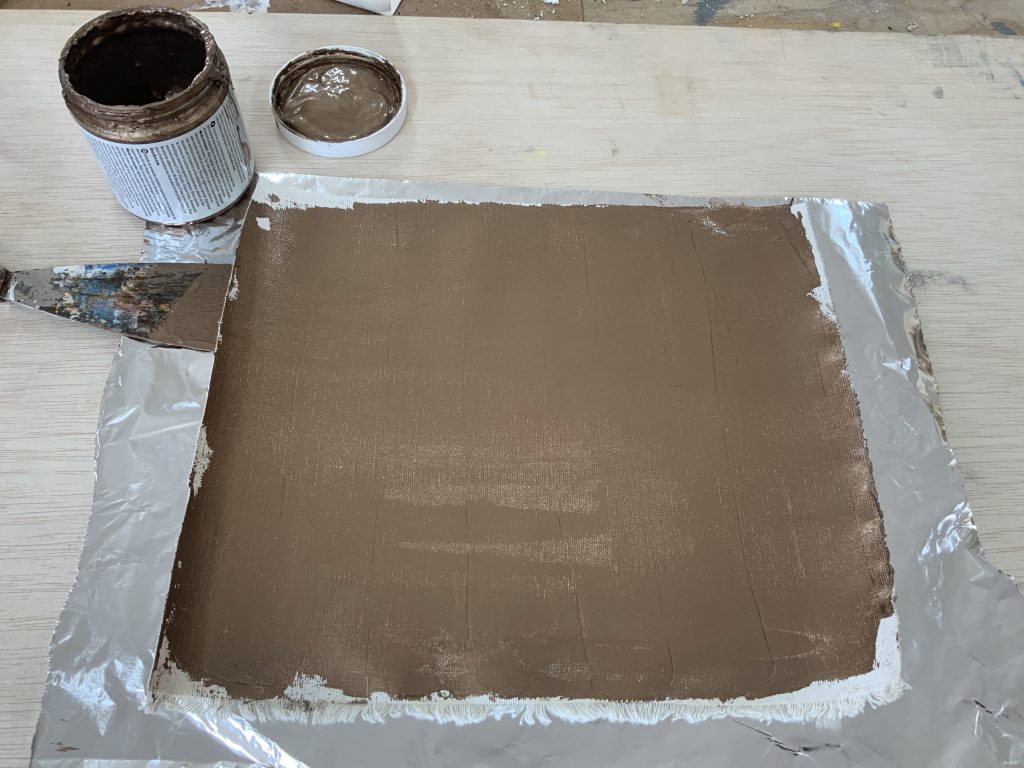
I have to admit that I was struggling with this material, it seemed I would not get any oxidation happening. I literally threw everything but the kitchen sink at the surface. I used acetone, which made a very slight impact – almost dull areas where it made contact with the surface. I added vinegar and Bicarbonate of soda mixture – getting it foaming, but not much reaction. I added an acrylic medium, which made the big white marks on Fig. In the end, I used a urine sample (my own) just to conclude that I did try.
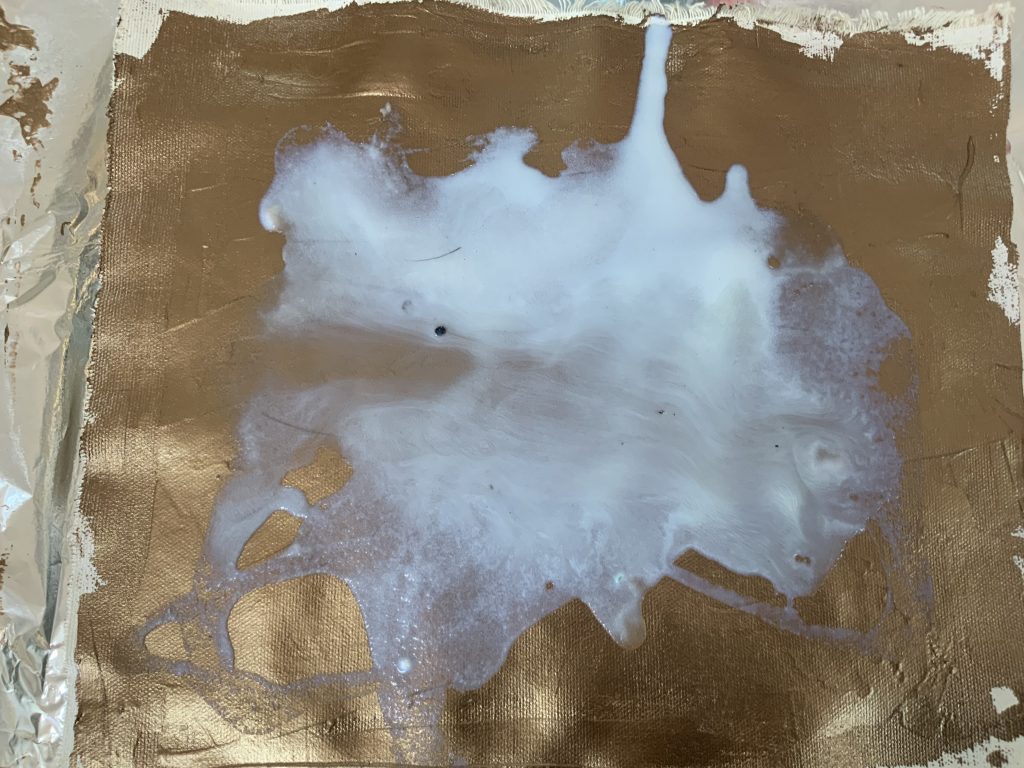
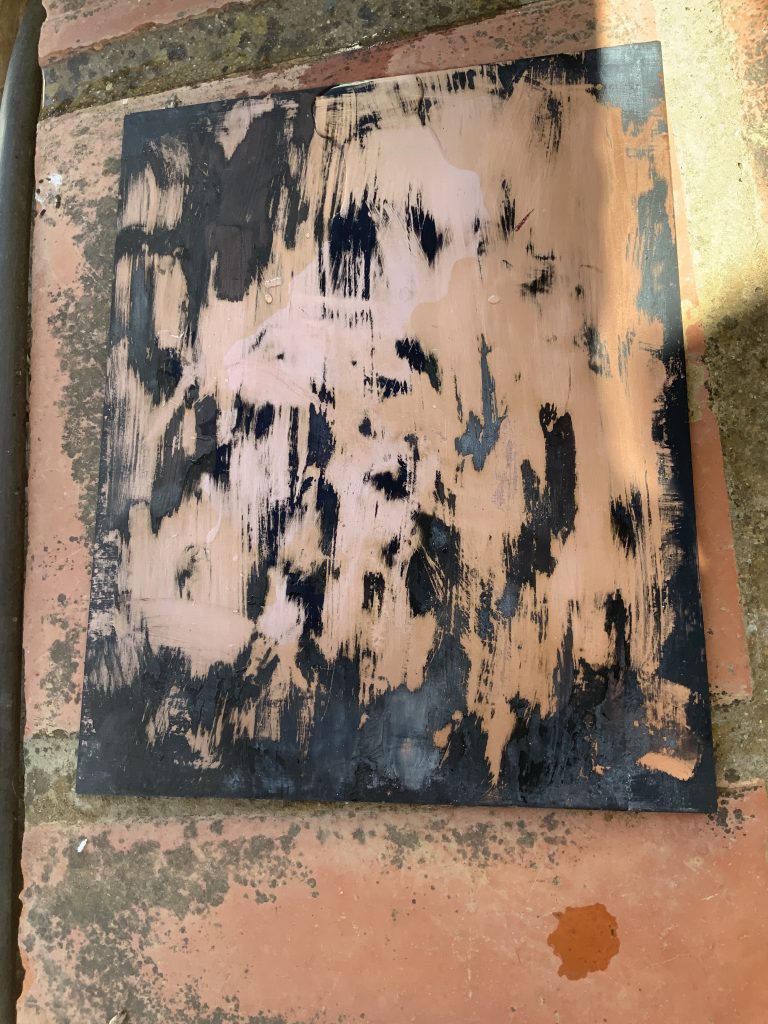
Reading more around Andy Warhol’s technique it became clear that he mixed pigment with acrylic medium and worked wet in wet with the urine onto this surface. In a Widewalls article, I read the experimented over a long time, not everything worked immediately. (Anapur, 2016) I had a piece of copper plate on which I have painted before, and at a stage, I started removing the paint, wanted to re-use it. I have painted with oil paints onto the copper plate in would say it was a successful effort, so as I support it does not resit paint. I decided to make use of the urine samples and poured them directly onto the plate – a reaction was starting – colours were showing as green, I added a drop of vinegar into the left corner as well as black coffee into the right corner, and placed it outside in the sun. I decide to rest my case and move on.
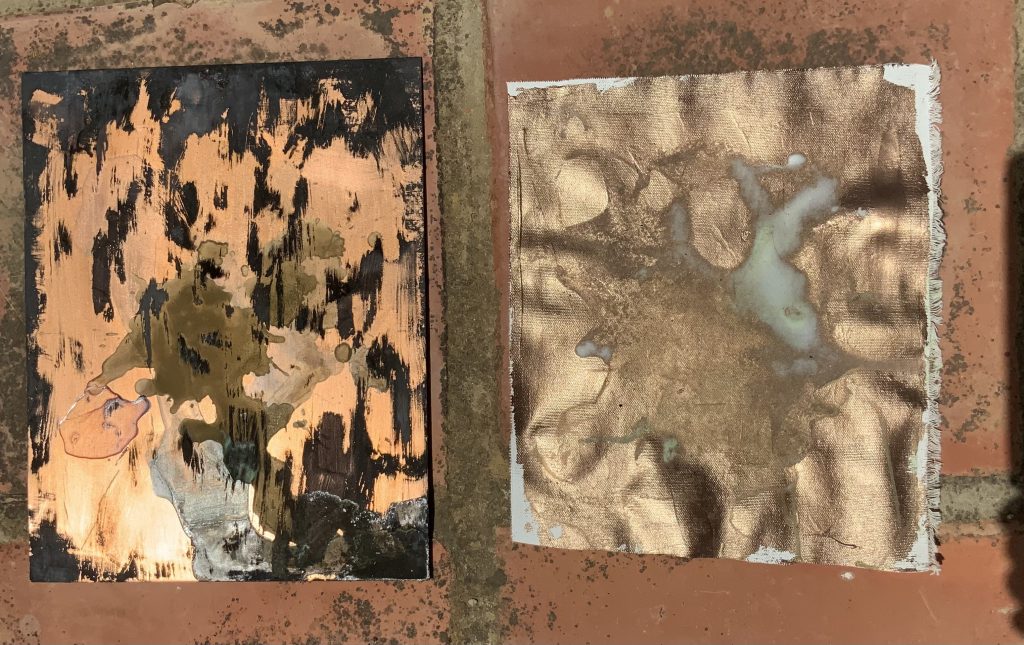
I do think I take away the idea of materials that takes time to show their presence, – the natural way of letting go and seeing what happens from the interference. It reminded me of lichens I have been reading about and if one could use a rubbing technique to paint/draw with them. I will continue to use a visual diary of this development on the copper plate. It is clear the coffee has left its own mark – I like the edges as boundaries of its mark on this material.
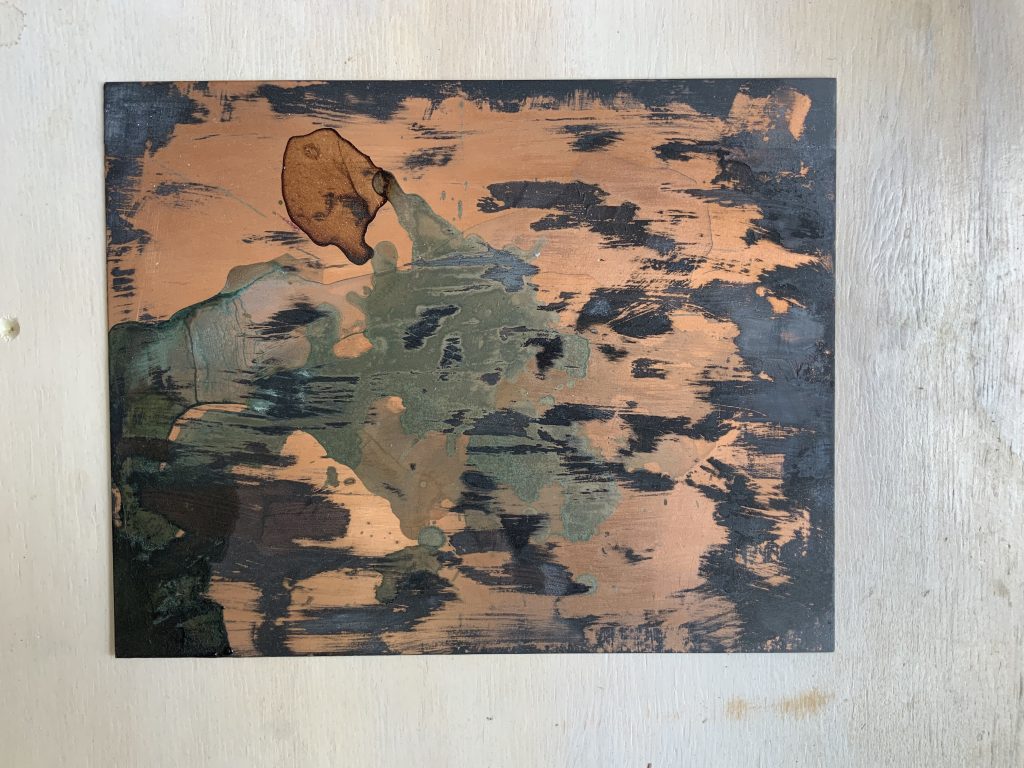
I took some Velour paper and oil pastels and went to do some rubbing on the paved blocks, covered with lichen next to a stone wall here outside our home. I made 4 different colour samples, after the first rubbing with charcoal, and would like to consider this technique more in my work – I enjoy the tactility of the textures on the surface. This leads me to consider the use of decalcomania -as I can use inks and make a painting without using a brush or standard painting methods. I have explored this earlier in my studies, and really enjoyed working with this method.
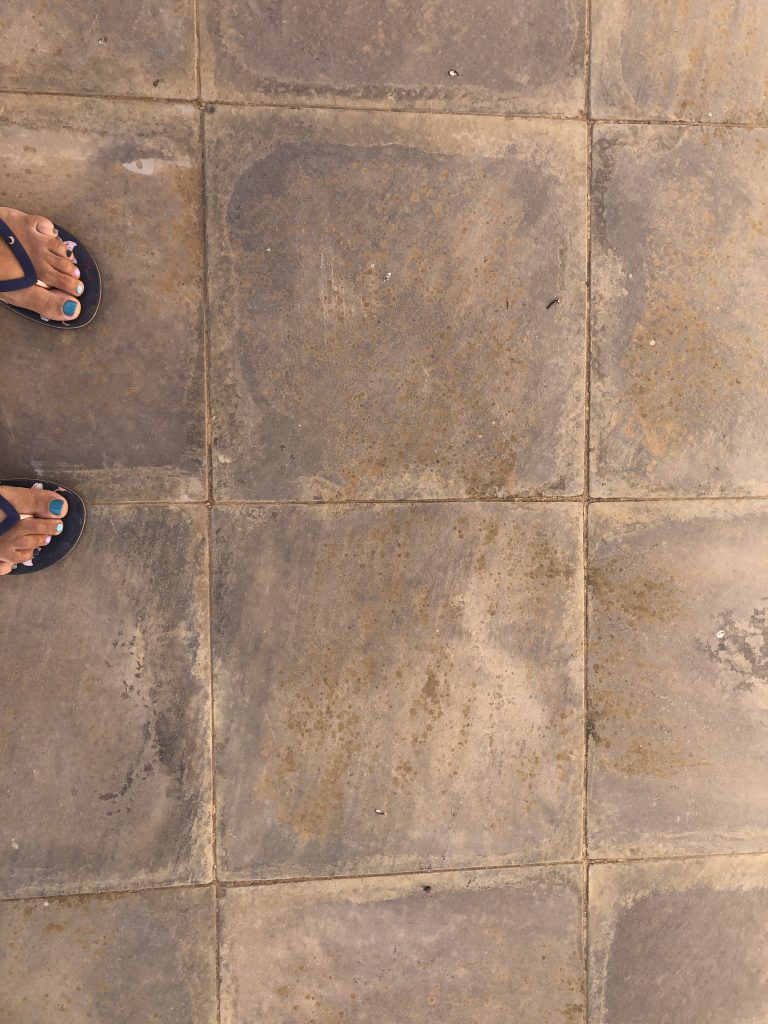
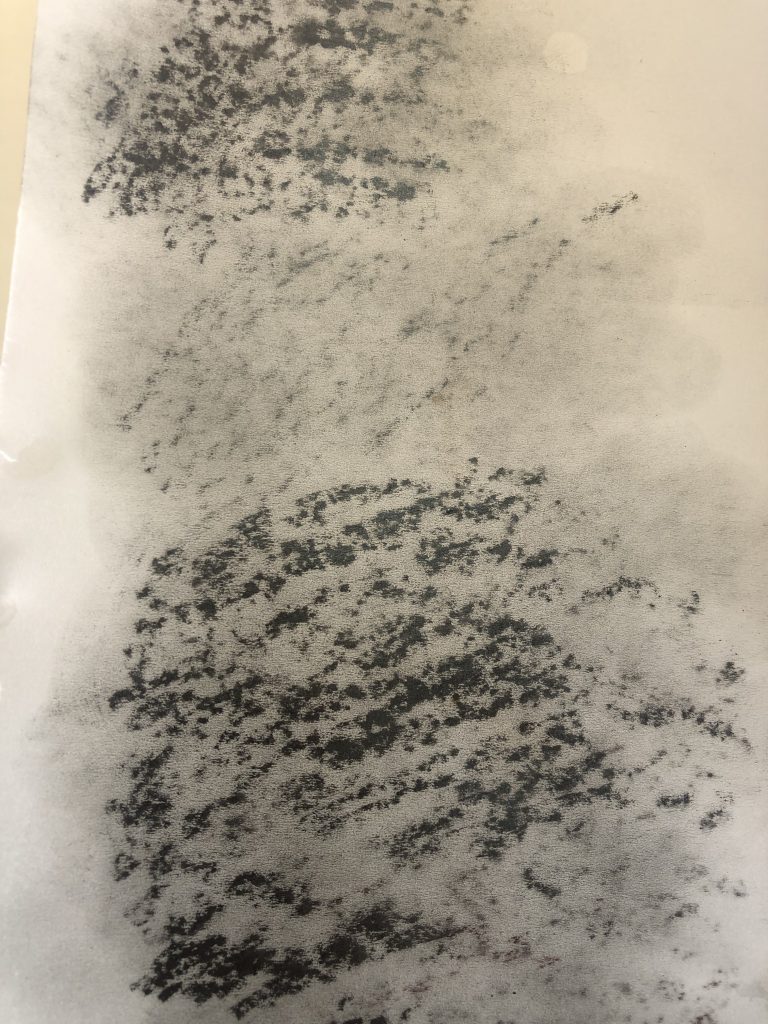
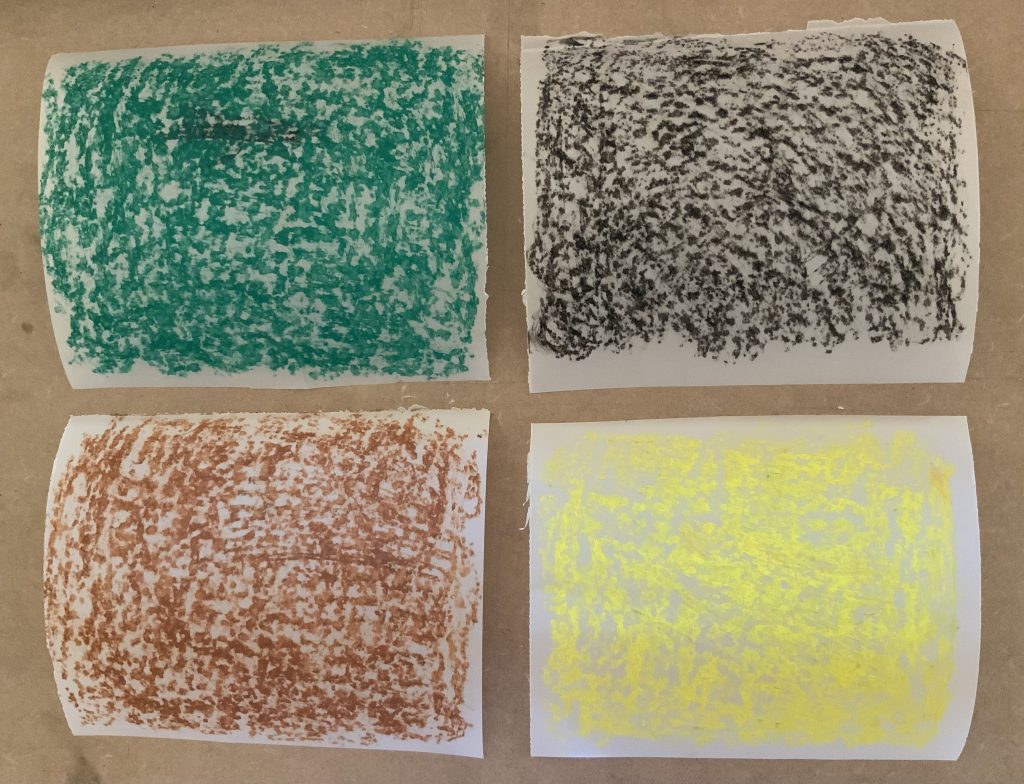
During this project and looking at oxides it could locally source, I read about an artist/ environmental activist, John Sabraw. who works with iron oxide which is extracted from remediating polluted streams. Most of these streams are polluted by acid mine drainage from abandoned coal mines. I can relate very well with his concern and here in South Africa water pollution due to mine pollution is a very big concern. I tried to buy the paint, but unfortunately, nobody has stock which I could buy.
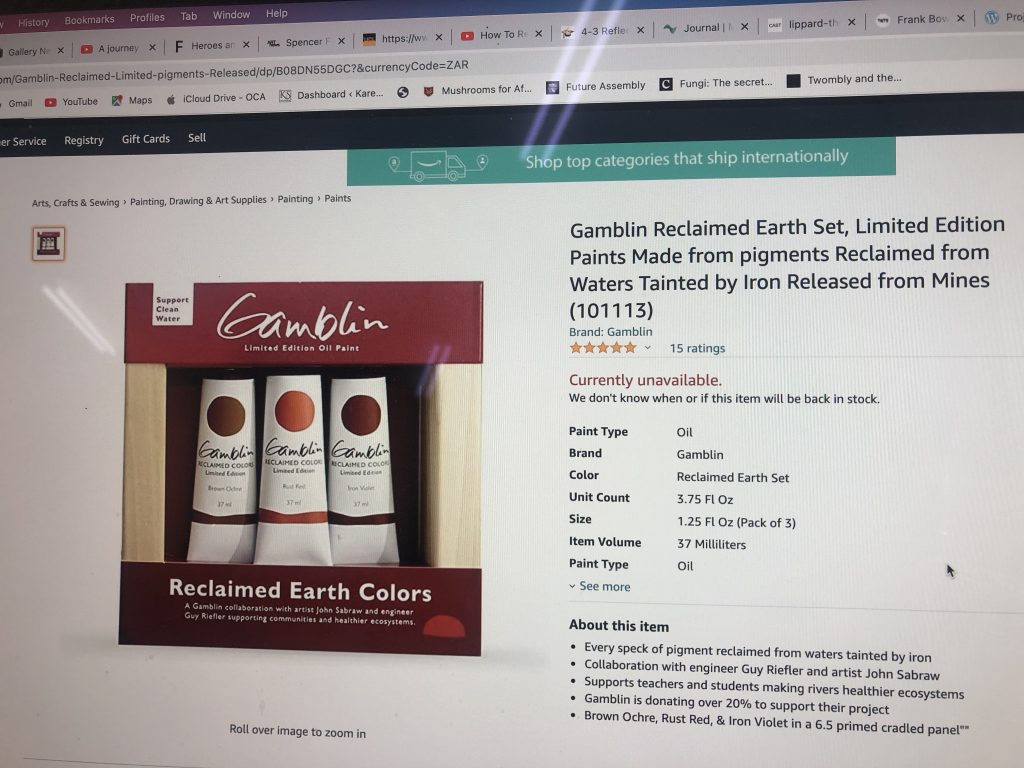
I tried my hand at Cyanotype to work with light as the ‘paint’.
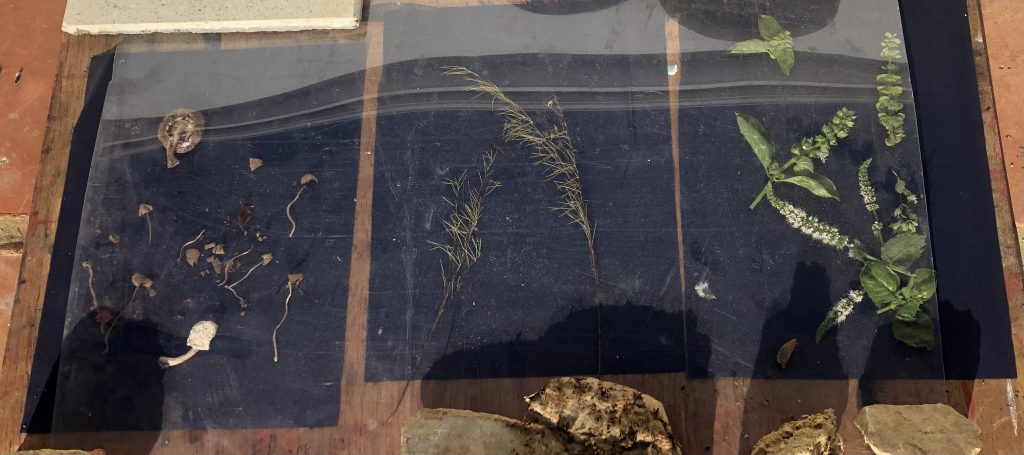
I had a few Cyanotype pretreated fabric sheets, used found materials onto the three sheets below, and placed them outside in the sun. The dried mushrooms can also work for my fungi project. I used herbs from my veggie patch and a piece of Rooibos Tea, which my cousin brought to me recently. Rooibos is a local indigenous plant used as tea. I realize that this is not painting – but I could say the organic forms are reacting with the materials on the surface of the canvas. I believe that is a good reason to also explore here. It makes me consider painting with Rooibos tea. My coffee experiment will also be shared here soon.
I considered random mark making with coffee – used my little espresso cup and smaller circular forms to press onto the surface, into that I made thumb markings by placing my left thumb into ink and pressing onto the surface with coffee rings.
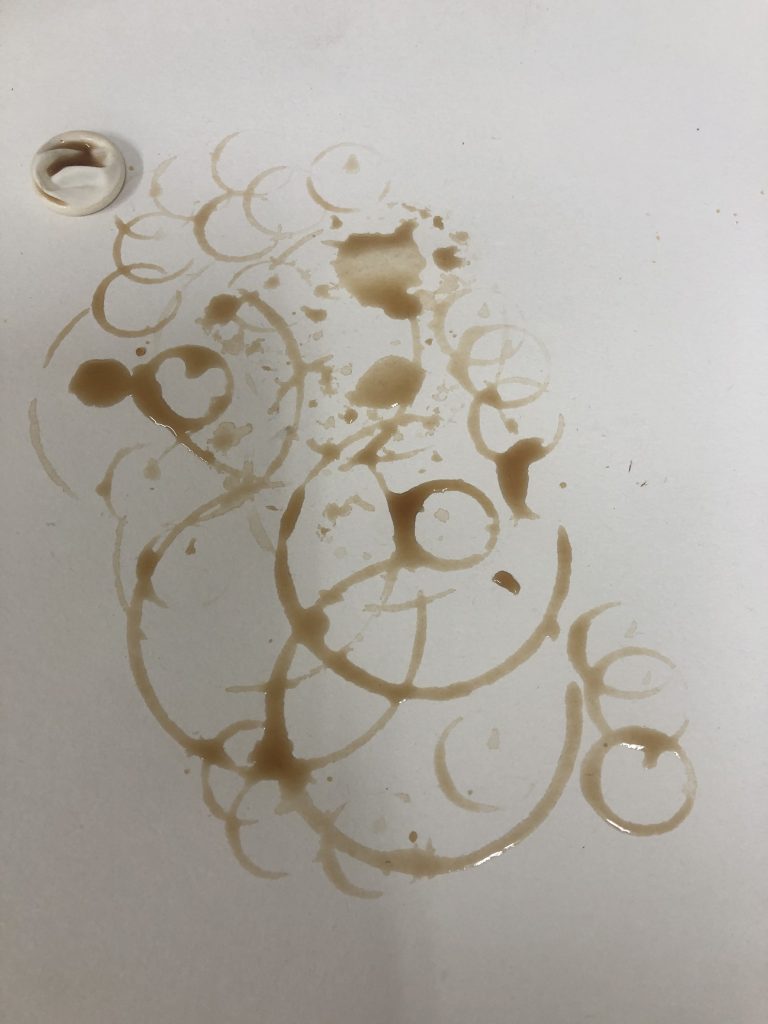
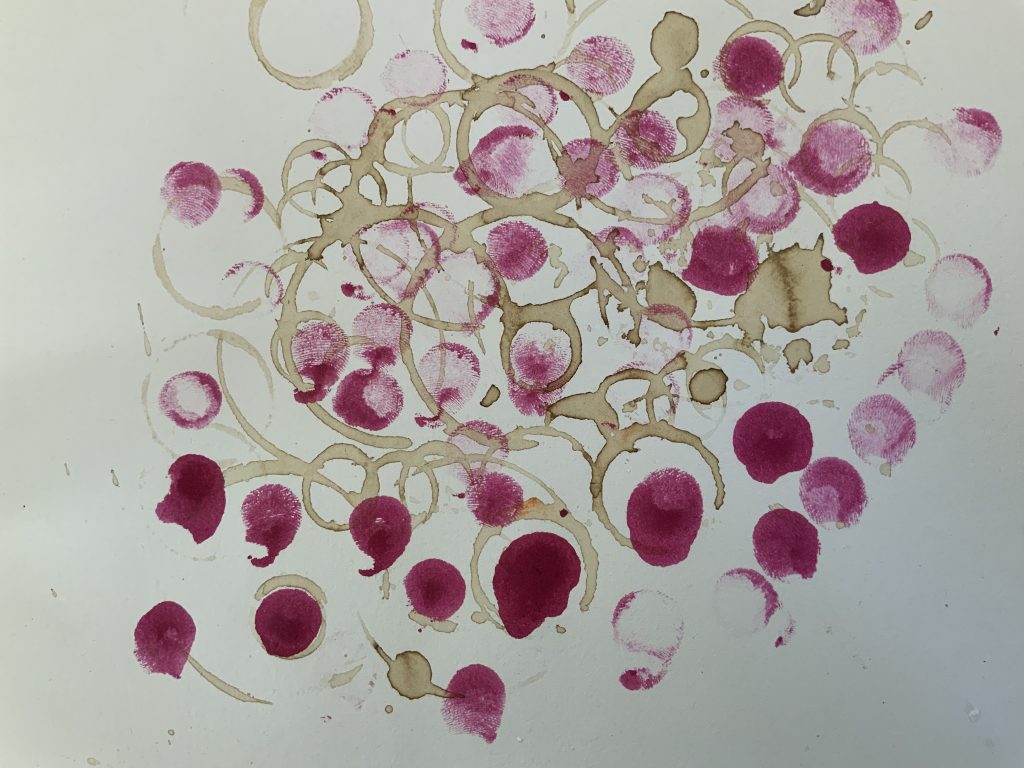

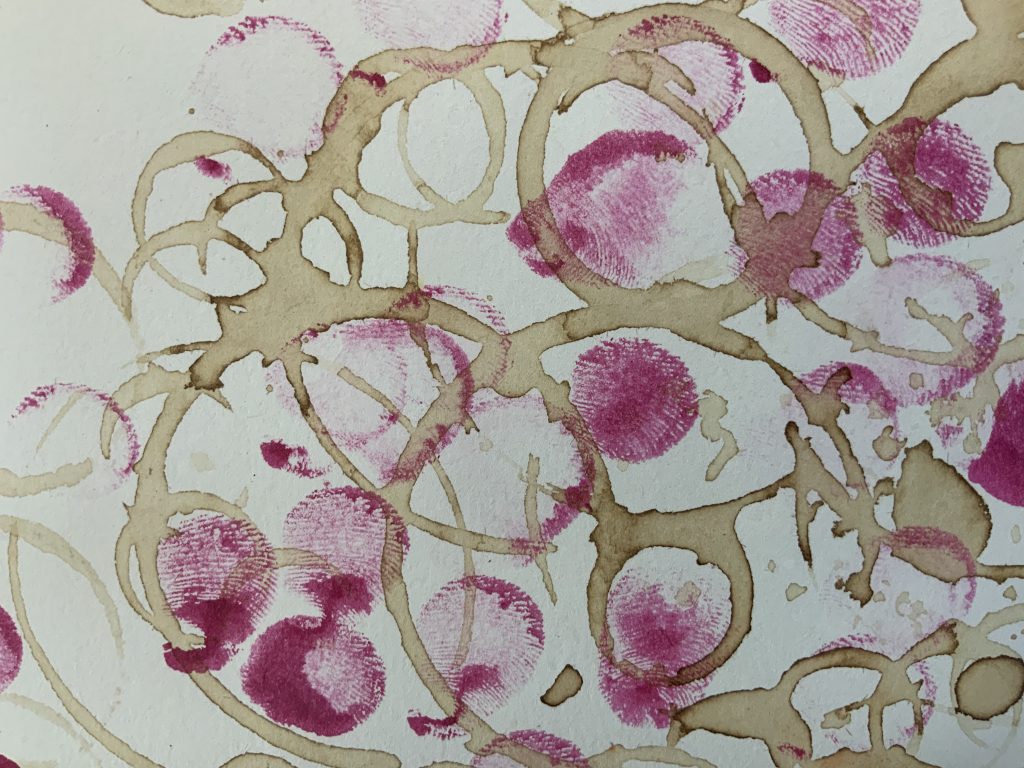
I did another coffee drawing and decided to use it as a background onto which I could work, by adding a wax layer onto it and then dusting it with charcoal powder. I liked the tones on the surface and decided to make a fungi drawing onto it, removing charcoal makes the figures and objects onto the work. It can be erased by rubbing charcoal powder onto it – I can develop this by adding paint and more charcoal lines.
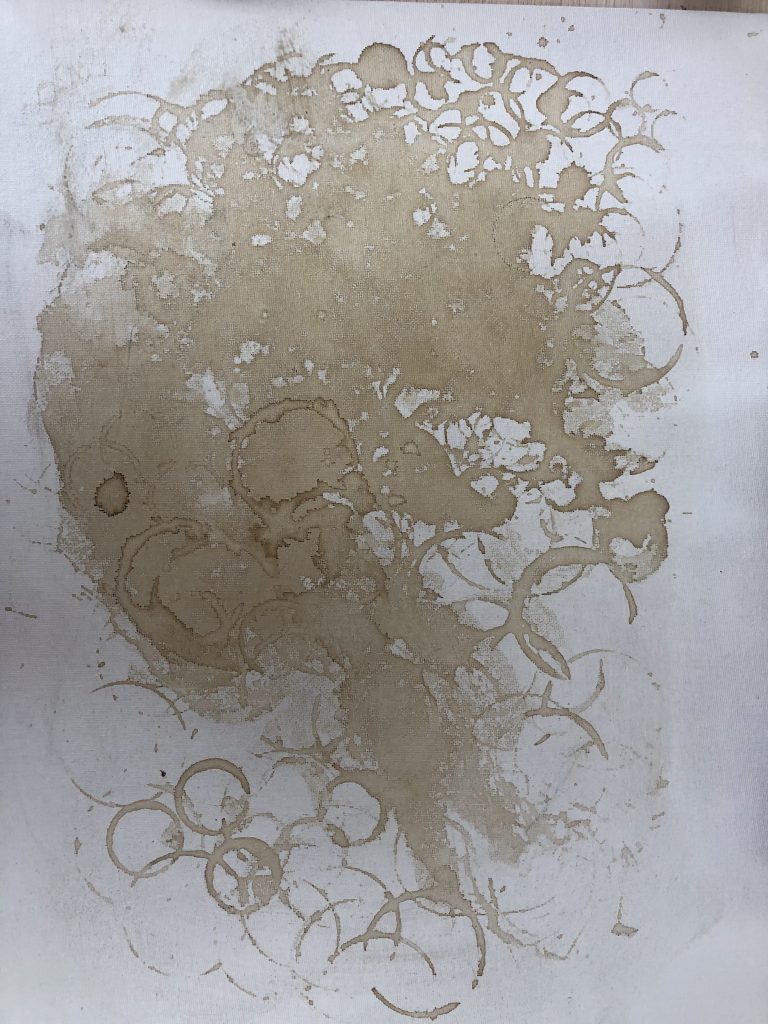
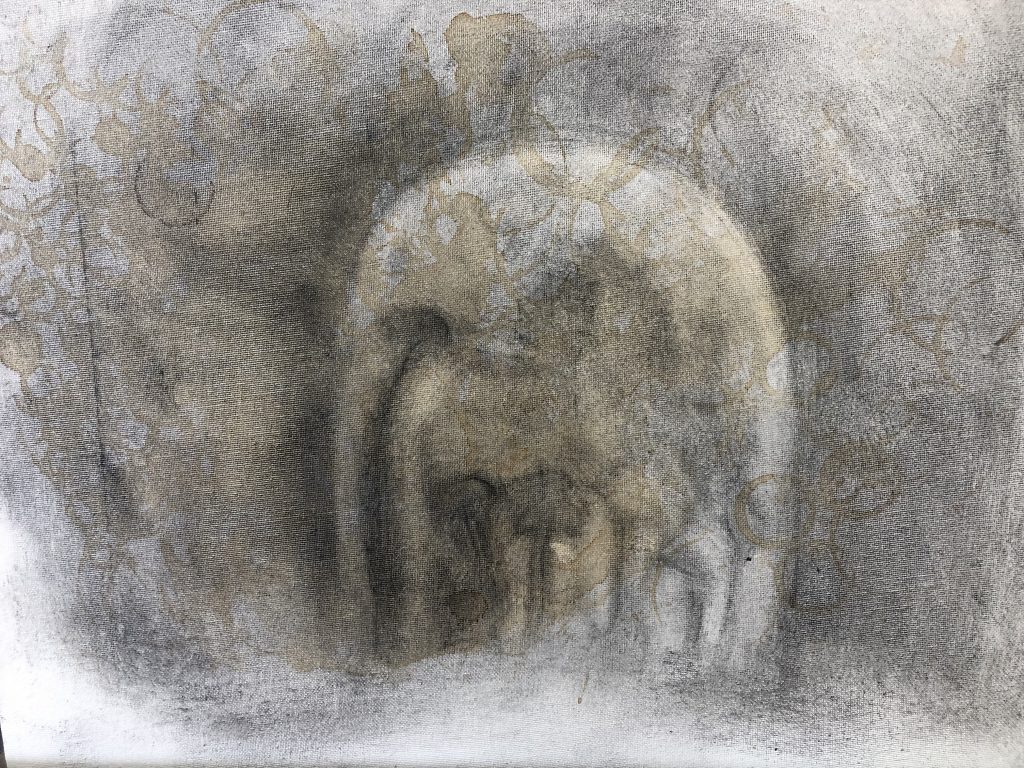
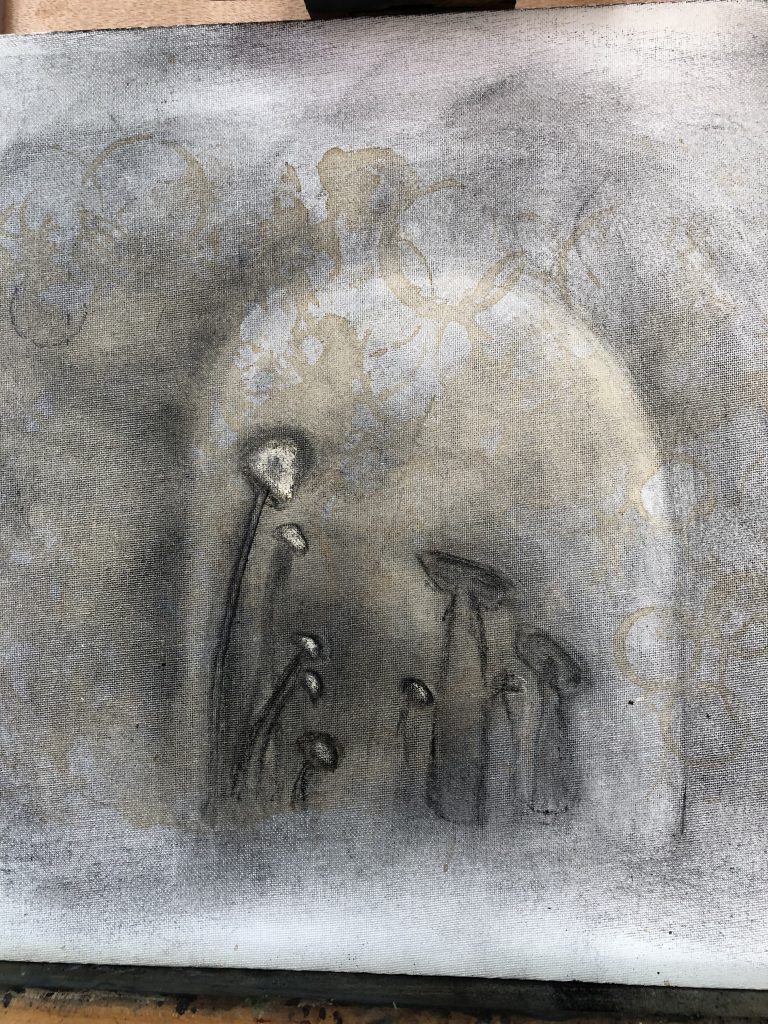
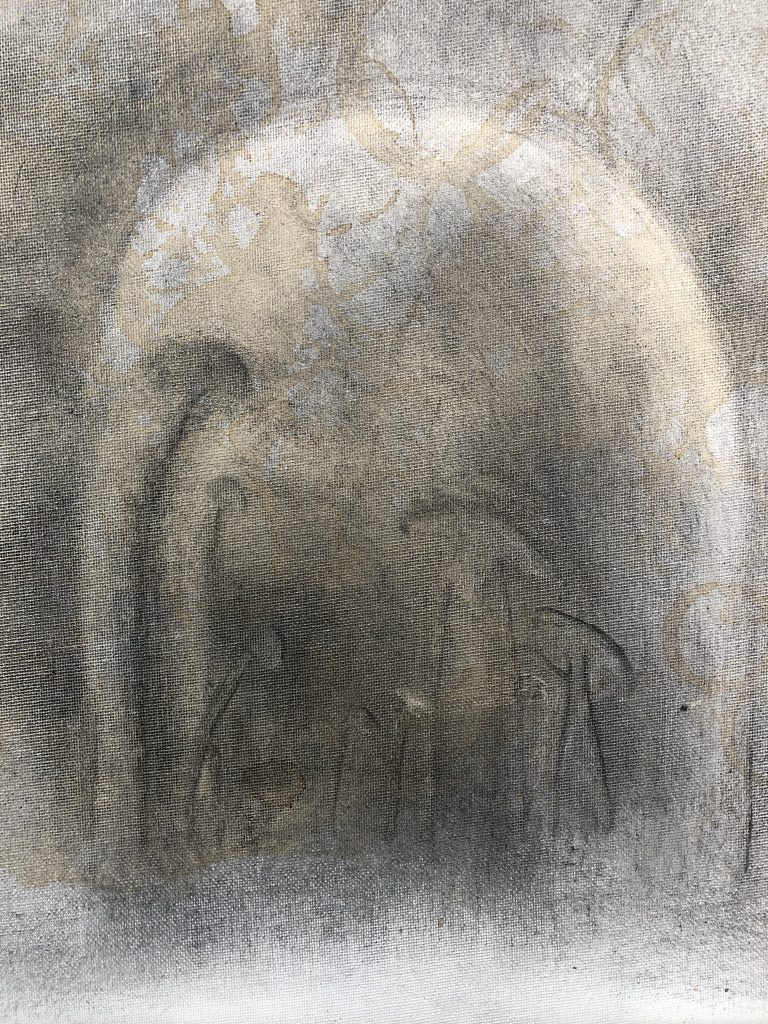
I prepared a canvas and then allowed thick drips to move on the painted surface and make its own form. As the paint was moved by gravity it made a dripping on the floor. The painting was ‘stuck’ to the floor through this paint. I loosened it and liked the paint that extends beyond the surface of the painting. Later when I looked at a video by R Johnson I felt here was some links to his work with the pouring of black soap and wax over a work. I see potential in this making.
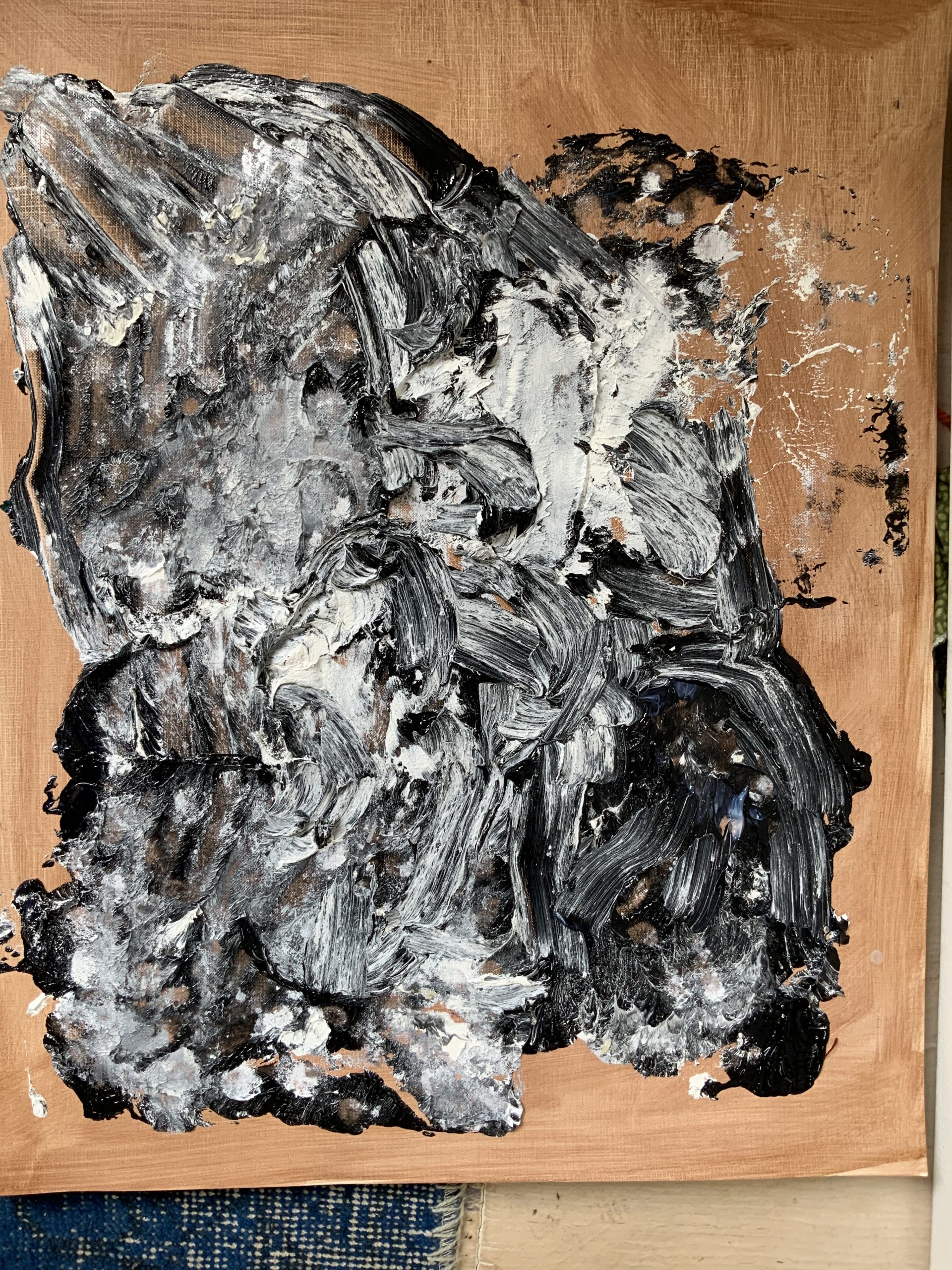
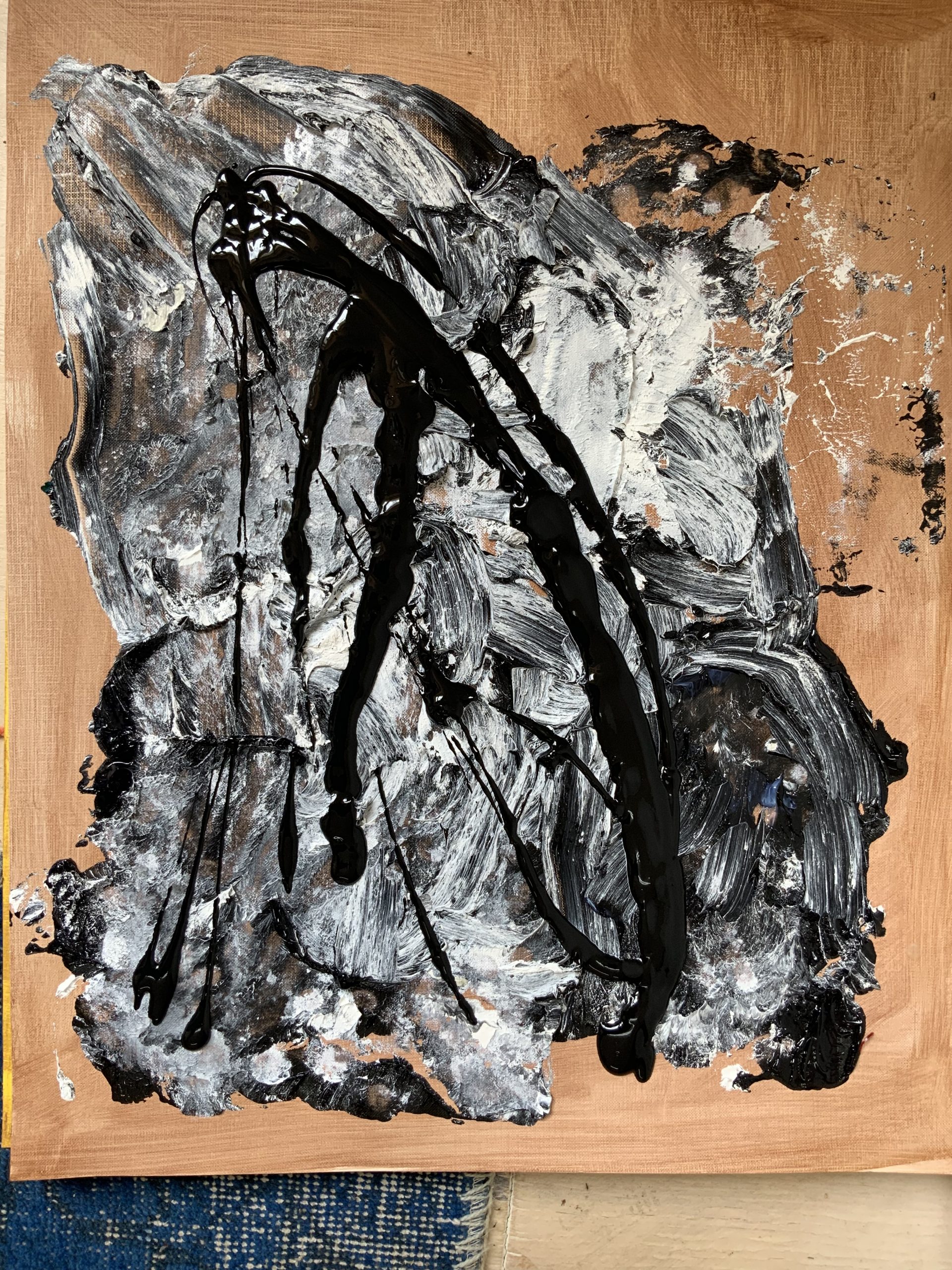
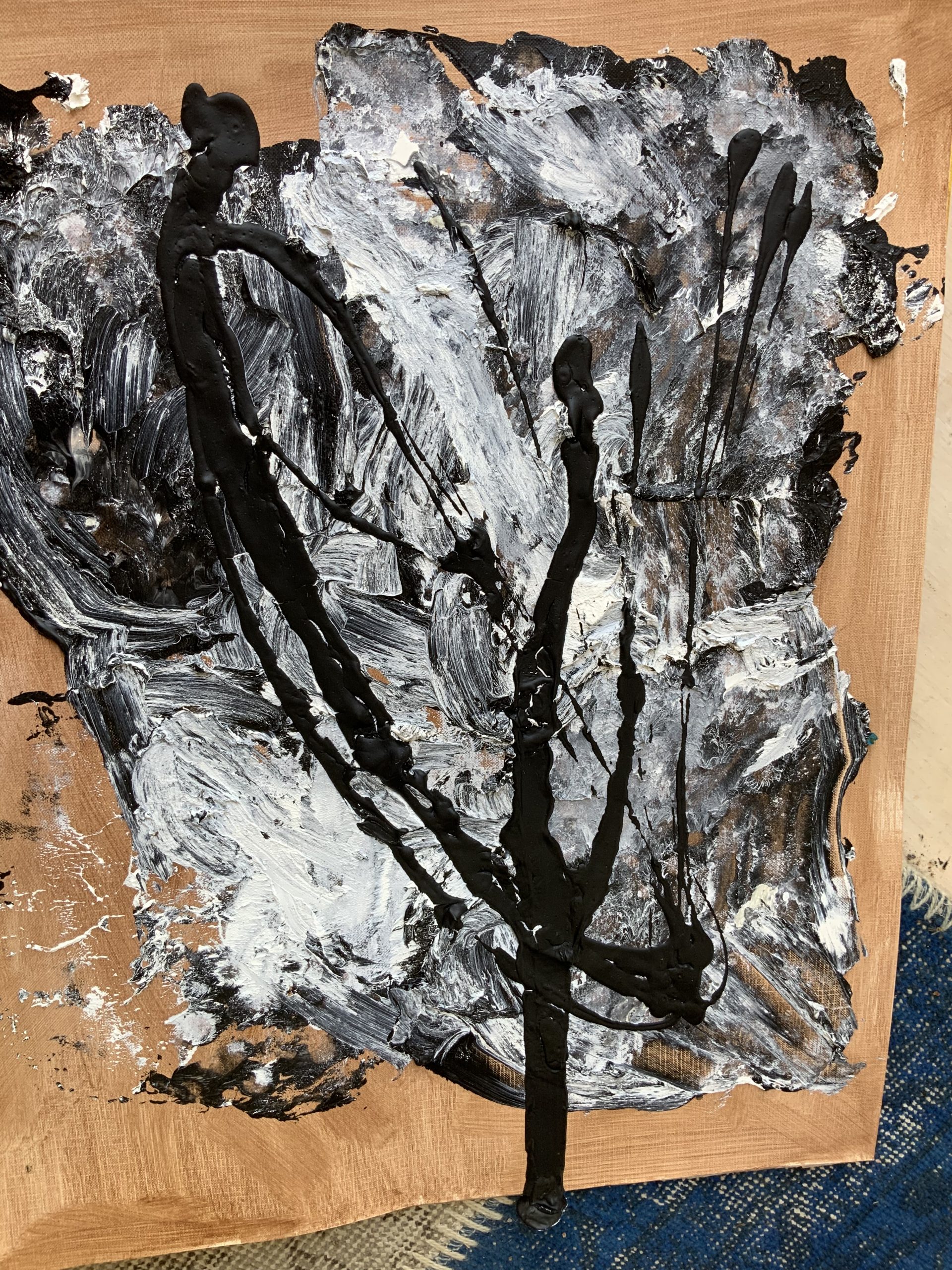
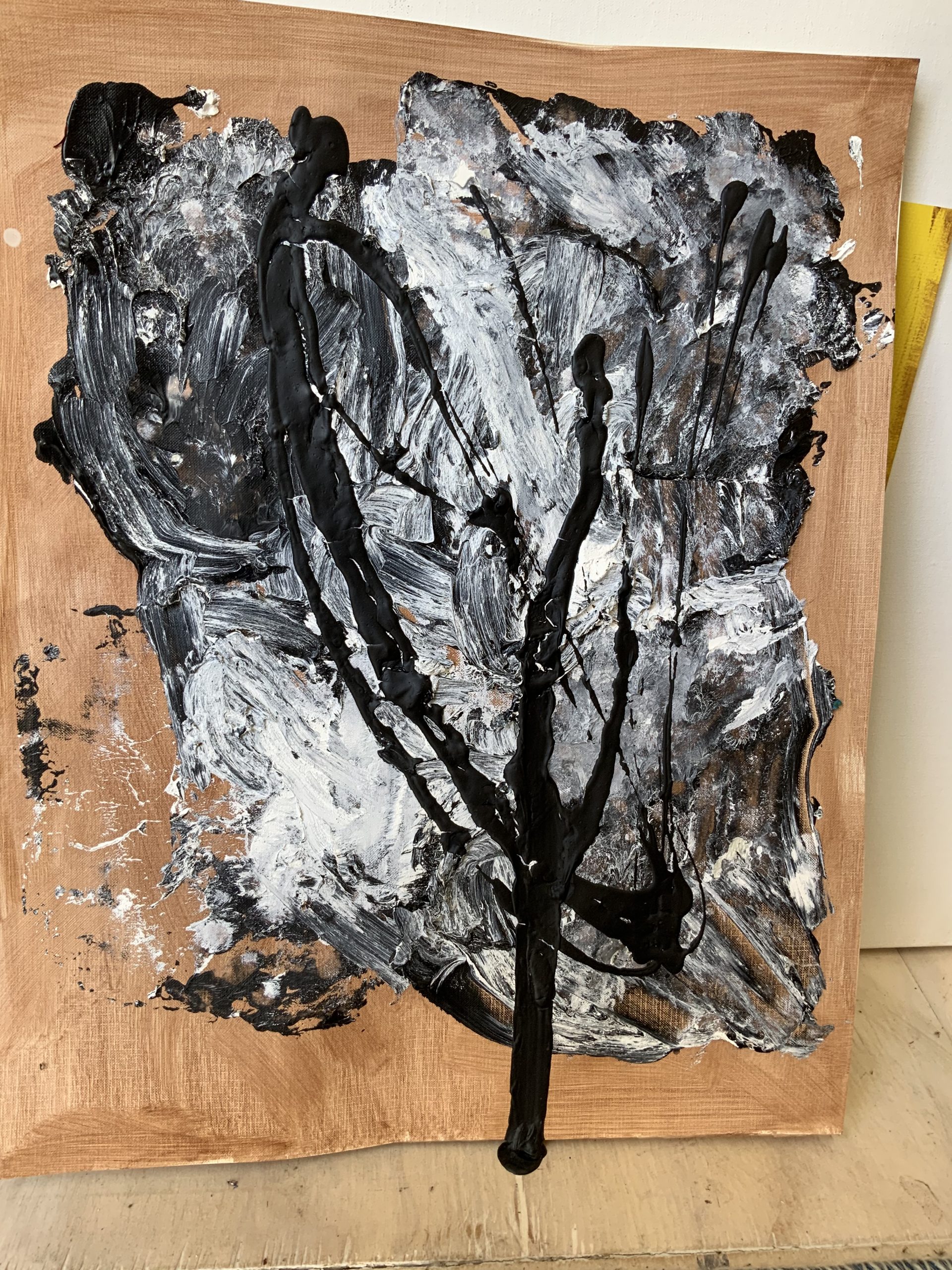
I decided to do a painting with water and charcoal powder. I used watercolour paper, dusted some charcoal powder on it, and placed it in a tub with water. I was not very happy with the outcome and as I taped them down to dry, I used the coffee I had used earlier to add to the painting.
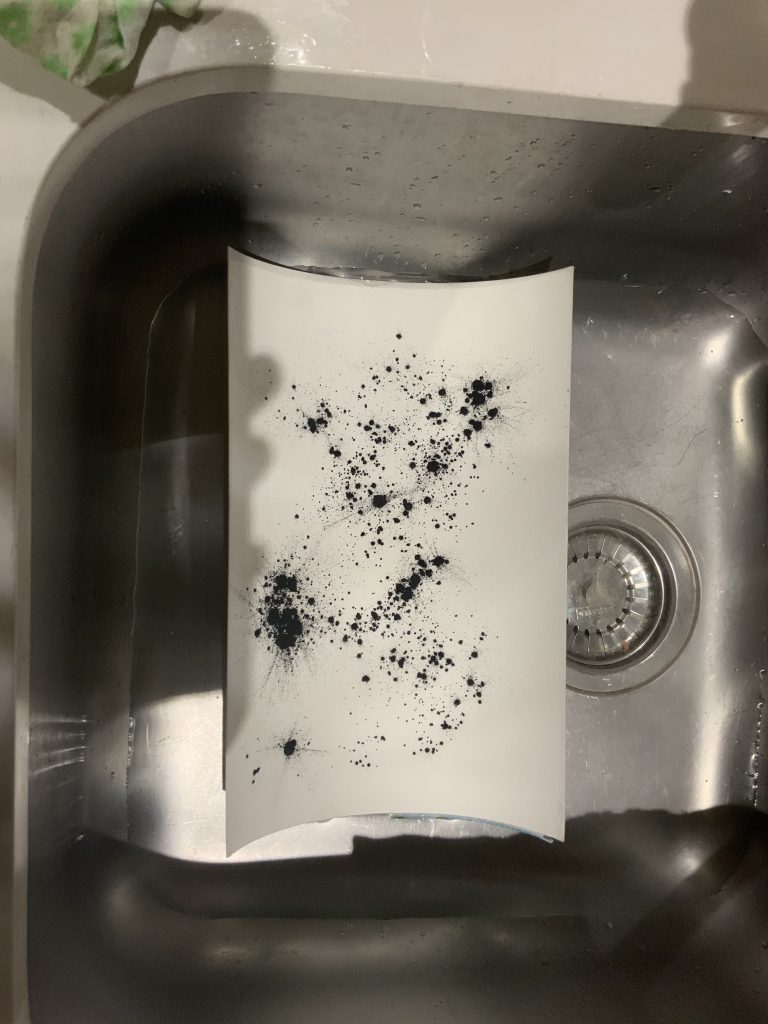
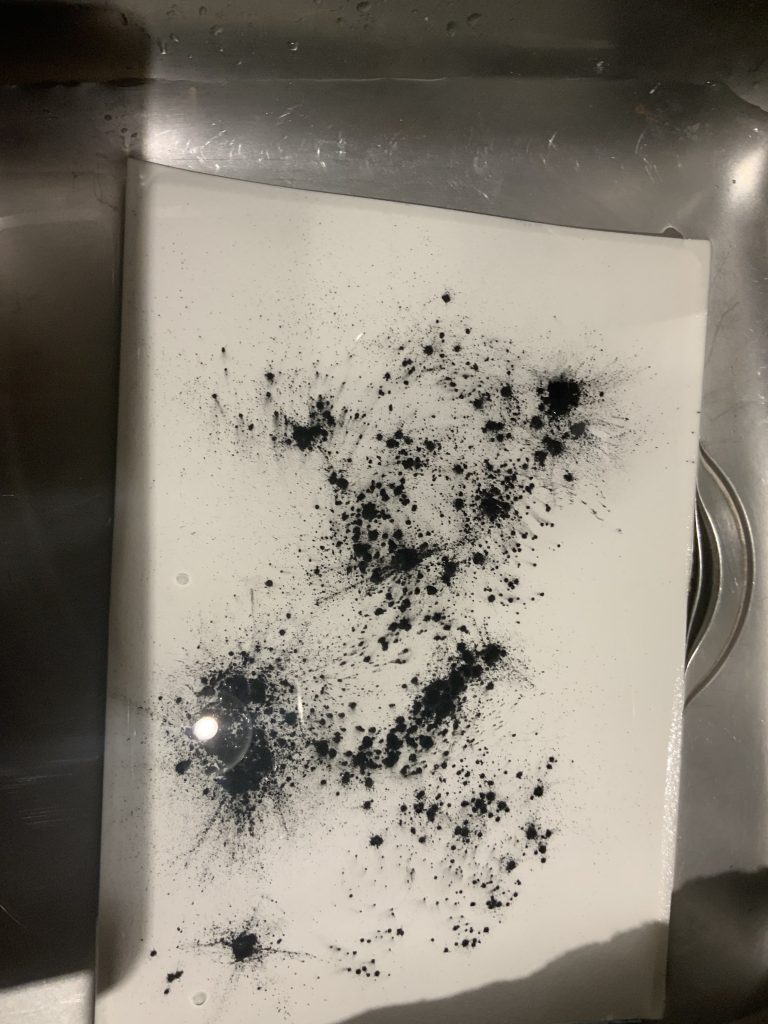
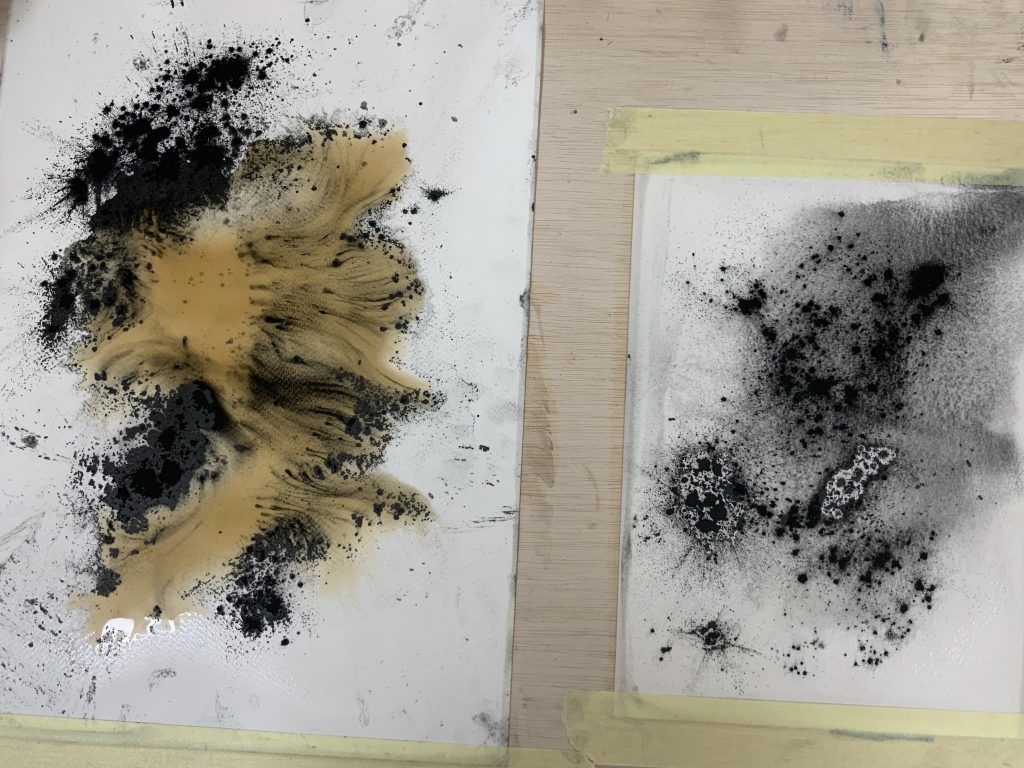
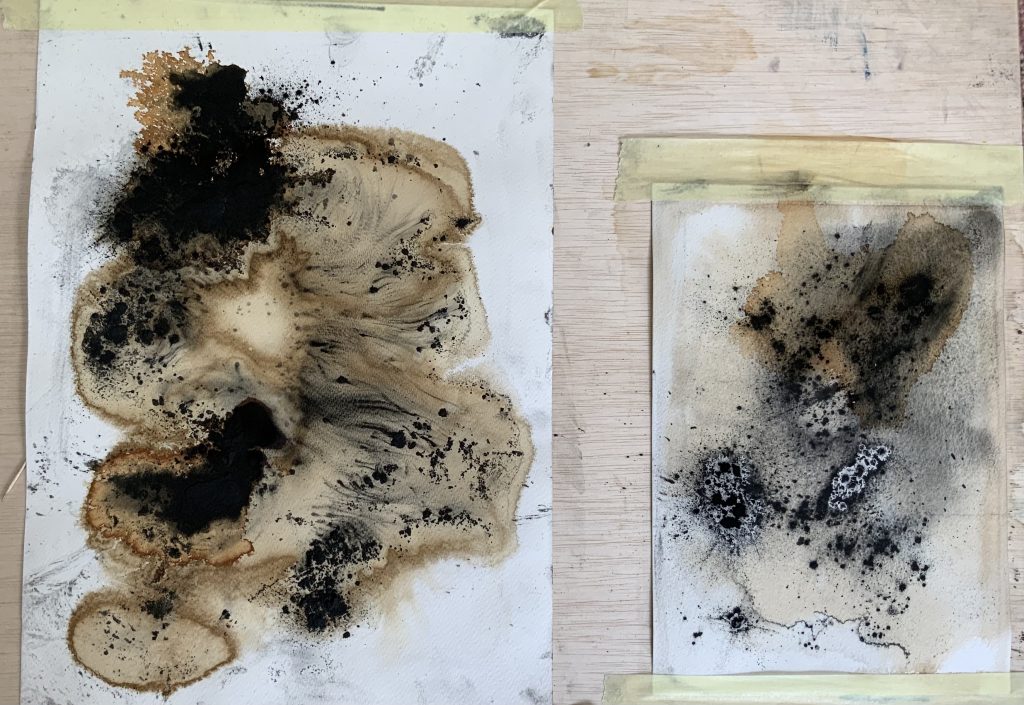
I thought about my relationship with charcoal – it is clear that this is my ‘go to’ material. I am more aware of the many possibilities I can still explore. I recently saw drawings made on wet material and would definitely explore this.
List of Illustrations for Project 4, Painting without Paint
Fig. 1 Johnson, R. (2017 ). Anxious Audiences [Oil and charcoal drawing/painting]Available at: the culturetrip.com/north-america/usa/articles/african-american-artist-rashid-johnson-talks-escapism-and-shea-butter/ (Accessed online 22/11/2021)
Fig. 2 – Fig. 5 Stander, K. (2021) Exploration with materials [nailvarnish, hair shampoo, acrylic medium on paper] In possession of: the author: Langvlei, Riebeeck West.
Fig. 6 Stander, K. (2021) Drawing Lines and Fungi [shampoo drawing on paper] In possession of: the author: Langvlei, Riebeeck West.
Fig. 7 Rasmussin, L.C. (2015) Loving Care interpretation [ink and hair] Available at: https://b-change.me/2015/02/07/human-paintbrush-lilibeth-cuenca-rasmussen/ (Accessed on 16/12/2021)
Fig. 8. Singer, Barry Gyotako Trout [print] Available at: https://www.studentartguide.com/articles/inventive-mixed-media-techniques. (Accessed online on 16/12/2021)
Fig. 9 – Fig. 11 Stander, K. (2022) Mushroom spoor [spoor print on paper] In possession of: the author: Langvlei, Riebeeck West.
Fig. 12 -Fig. 13 Stander, K. (2022) Tomato explorations [tomato, acrylic, turmeric and soil on paper] In passion of: the author: Langvlei, Riebeeck West.
Fig. 14 Stander, K. (2022) Skull [beetroot on paper] In possession of: the author: Langvlei, Riebeeck West.
Fig. 15 – Fig. 17 Stander, K. (2022) Explorative drawing [wax and charcoal on paper] In possession of: the author: Langvlei, Riebeeck West.
Fig. 18 Stander, K. (2022) Mycelium explorations [wax and charcoal drawing on paper] In possession of: the author: Langvlei, Riebeeck West.
Fig. 19 – Fig. 21 Stander, K. (2022) Developing pastel drawing with sprayed water [Pastel and charcoal on paper] In possession of: the Author: Langvlei, Riebeeck West.
Fig. 22 Stander, K. (2022) Sunflower [pastel, charcoal on paper drawing] In possession of: the author: Langvlei, Riebeeck West.
Fig. 23 Stander, K. (2022) Collage [dryer fluff, beetroot sap, acrylic medium, ink on canvas] In possession of: the author: Langvlei, Riebeeck West.
Fig. 24 Stander, K. (2022) Drawing on wax [charcoal and shoe wax on Pastel paper] In possession of: the author: Langvlei, Riebeeck West.
Fig. 25 Stander, K. (2022) Fungi drawing [charcoal and shoe wax on Pastel paper] In possession of: the author: Langvlei, Riebeeck West.
Fig. 26 Stander, K. (2022) Metallic paint exploration [metallic paint on canvas paper] In possession of: the author: Langvlei, Riebeeck West.
Fig. 27 Stander, K. (2022) Metallic paint [metallic paint, vinegar, salt on canvas paper] In possession of: the author: Langvlei, Riebeeck West.
FIg. 28 Stander, K. (2022) Metallic paint on canvas exploration [Metalic paint and Acetone] In possession of: the author: Langvlei, Riebeeck West.
Fig. 29 Stander K. (2022) Metallic paint on canvas exploration continues [Metallic paint, bicarbonate of soda and vinegar] In possession of: the author: Langvlei, Riebeeck West.
Fig. 30 Stander K. (2022) Copper plate painting explorations [bicarbonate of soda and vinegar on copper plate] In possession of: the author: Langvlei, Riebeeck West.
Fig. 31 Stander K. (2022) Copper plate with oxidation [coffee and urine on copper plate] In possession of: the author: Langvlei, Riebeeck West.
Fig. 32 Stander, K. (2022) Lichen on paving stones [photo image] In possession of: the author: Langvlei, Riebeeck West.
Fig. 33 Stander, K. (2022) Lichen copy [charcoal on velour paper] In possession of: the author: Langvlei, Riebeeck West.
Fig. 34 Stander, K. (2022) Series of Lichen [Oil pastels on velour paper] In possession of: the author: Langvlei, Riebeeck West.
Fig. 35 Stander, K. (2022) Cyanottype print [fabric and cyanottype chemicals] In possession of: the author: Langvlei, Riebeeck West.
Fig. 36. Stander, K. (2022) Coffee stains [coffee and beetroot sap on canvas paper] In possession of: the author: Langvlei, Riebeeck West.
Fig. 37. Stander, K. (2022) Mushrooms under a dome, a work under investigation [charcoal, coffee on canvas board] In possession of: the author: Langvlei, Riebeeck West.
Fig. 38 Stander, K. (2022) Blob [pouring acrylic on canvas board] In possession of: the author: Langvlei, Riebeeck West.
Fig. 39 Stander, K. (2022) Water paintings x 2 [charcoal and coffee in water on watercolour paper] In possession of: the author: Langvlei, Riebeeck West.
Bibliography
Anapur, Eli. (2016) How Experimental Were the Andy Warhol Piss Paintings Actually? [online] Available at: How Experimental Were the Andy Warhol Piss Paintings Actually? (Accessed on 10/12/2021)
BBC News. (2020) How Soap And Shea Butter Can Make Art. [online] Available at: https://www.bbc.co.uk/news/av/world-radio-and-tv-20269460/rashid-johnson-creates-art-with-soap-and-shea-butter> (Accessed on 23/11/2021)
Sillman, Amy (2020) Fall 202 Alex Katz Chair: Painting [online video] Available at: https://www.youtube.com/watch?v=ajCOPWVciwU (Accessed on 12 January 2022)
Sutera, C. (2011) Educational Uses of Gyotaku or Fish Printing [Smithsonian online article] Available at: https://ocean.si.edu/conservation/get-involved/educational-uses-gyotaku-or-fish-printing ( Accessed on 16 December 2021)
Wei, Lily (2014) Rashin Johnson: Magic Numbers
Reflection
Considering my material list and finding that I was drawn to certain materials and how they resisted or mixed into the painting. The association with my purple shampoo was enjoyable, the painting smells very nice. I have by now read Petra Lange-Berndt’s article, called How to be complicit with materials and (2015:18-19) when she writes about making materials laugh, I am reminded of materiality as a ‘perpetuator’ of gender hierarchies. In this painting, the shampoo I use to ‘enhance’ (celebrate) my grey hair can be seen as a viewpoint around female ageing and body/age shaming. I like to think of this material that “becomes traces that are entangled in the web of life” as Lange-Berndt writes here. This motivated me to do something with the fluff I collected from our tumble drying machine – to me it represents work, doing laundry, but also the focus on the dependency of electricity versus natural heat to dry clothes – softer feel and convenience of drying even when it rains or there is a dust/wind storm outside.
Rather, she proposes, “Agency is a matter of intra-acting; it is an enactment, not something that someone or something has. Agency cannot be designated as an attribute of ‘subjects’ or ‘objects'” (ibid.). Barad thus redefines agency as a matter of intra-action: a neologism signifying what she describes as “the mutual constitution of entangled agencies” (Barad 2007, 33).
I wanted to read more about Piero Manzoni and understand his questions with regards to objects he made and how he worked and thought about making art. On JSTOR.org I found a journal article that was published in October 2001. (Vol. 95: pp. 28-53) and here Jaleh Mansoor discusses Manzoni’s ideas around organized disintegration. I saw his Achrome with bread rolls series and understand it as a way to explore possibilities, like monochrome, the grid, and the surface. The rolls eventually become objects as well as the ground – a form of oscillation is seen within the materials. As I understand, the grid and monochrome were seen as already-made forms that predetermine the surface. Now Manzoni puts the bread rolls into this grid, a relief is formed by painting kaolin over the surface. – a type of resists? I think one can say it becomes a redoubled grid/monochrome work, as Mansoor writes about this. (Mansoor, 2001:33) I learn that Manzoni now insists that the canvas can no longer be “the utopia of an aesthetic order or the folly of idealism without concrete human origin, an impersonal program whose sole and squalid presence resides in the creation of matter. Rather it will be a living flesh, direct and scalding” So matter is understood as an actor in the process and in artistic production? One can see how the bread rolls through shadows over the grid as they are taking up space in the grid. The white kaolin appears both solid and liquid. The artists left the objects and materials to bond or to resist. In a way, the work becomes continually active, with no control. This reminds me of new materialist theories. I can look at the canvas as a ‘receptive agent’? The surface is dynamic and not inanimate. Is it food? Is it an object? Is it art?
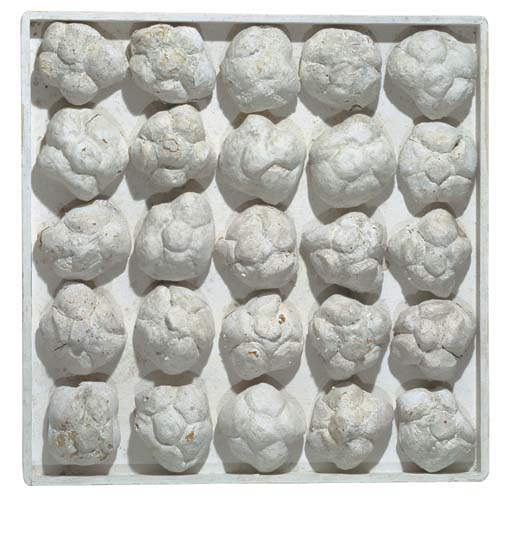
The works below shows how the artist, Andy Warhol have on a larger scale experimented with unconventional painting materials. He started with this experimentations during 1977.when he used a variety of metalic paints as background, as well as different or varying fluid and food intake for urine samples.
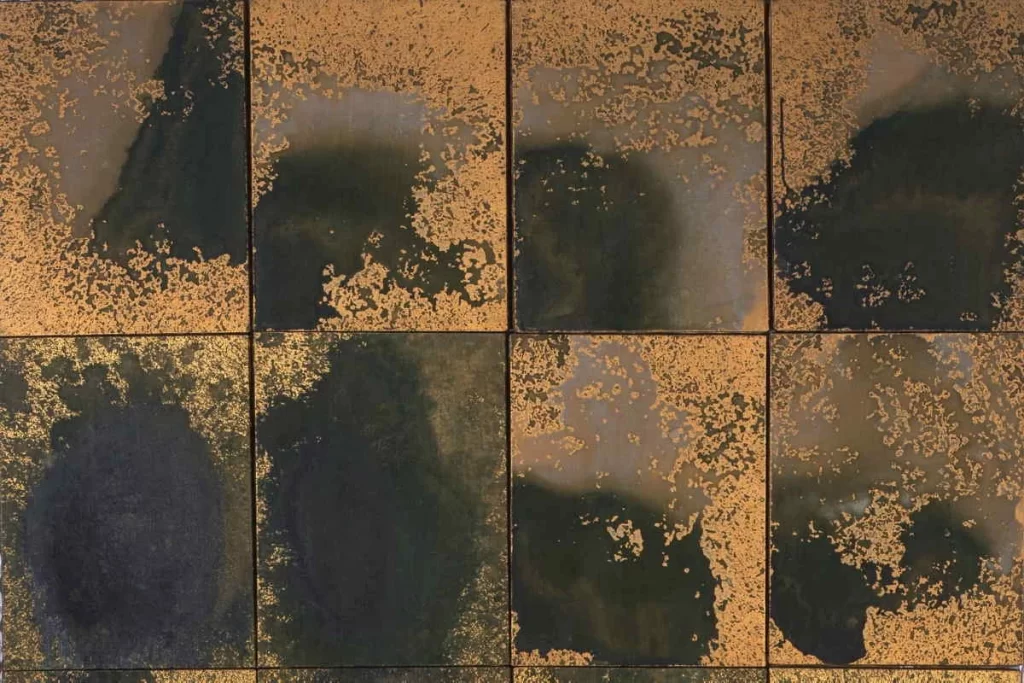
Looking at the process of making one can say that the use of body in these oxidation paintings is limited to the application of metallic colors on a surface and later urinating on it, but the body remains a significant element as a material. It makes me wonder about using one’s own hands or fingerprints in works – marks but also as objects of being in the work and leaving traces. I later read that Manzoni explored this idea. When I look to my efforts to ‘re enact’ this work, I have to consider how I think about material resistance, can I say that it showed that the material had a capacity to impede my efforts to master or control it? I also learn that there is a lot to know about materials and how to use it, my learning curve is not very well developed. I am also more aware of time and space within making a work – I had to allow for time to move on and the work to develop over time.
I looked back in my notes around method and considered the following suggestion: “Rather than creating an image, the emphasis here is to create (and potential extend) a material surface of texture, tone and/or colour, to transform the canvas” (Painting 2; Studio Practice Study notes:84)
I decided to explore more materials and did a painting/print with mayonnaise and our bread culture (yeast). Below is a few images showing the documentation over two days:

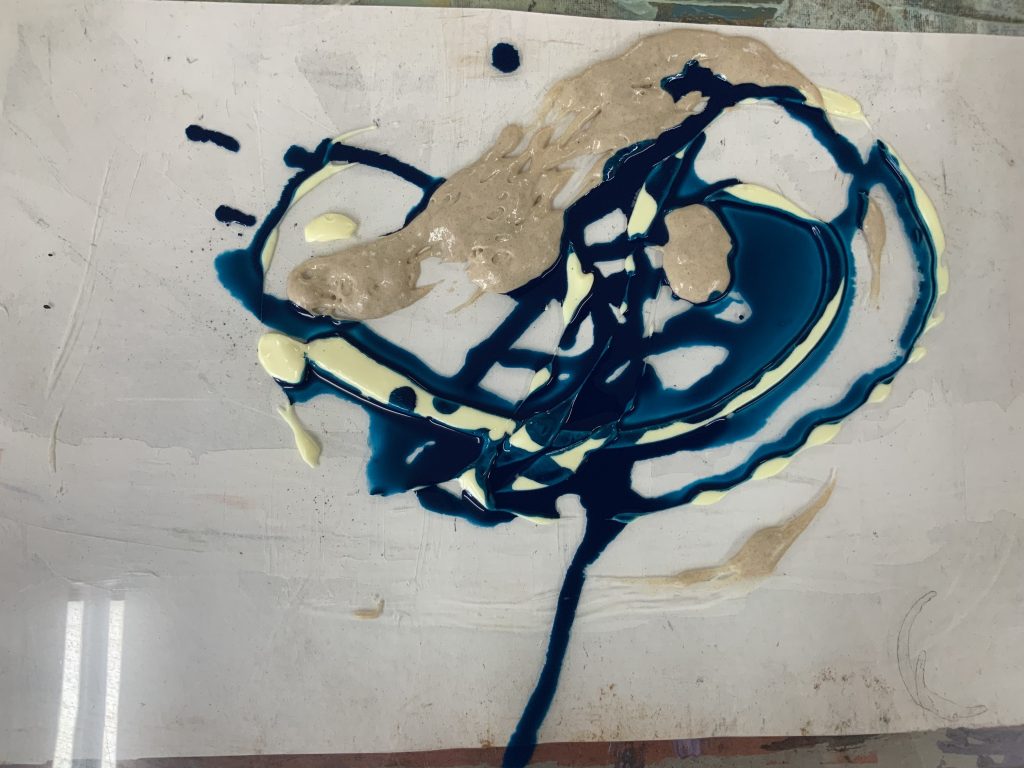
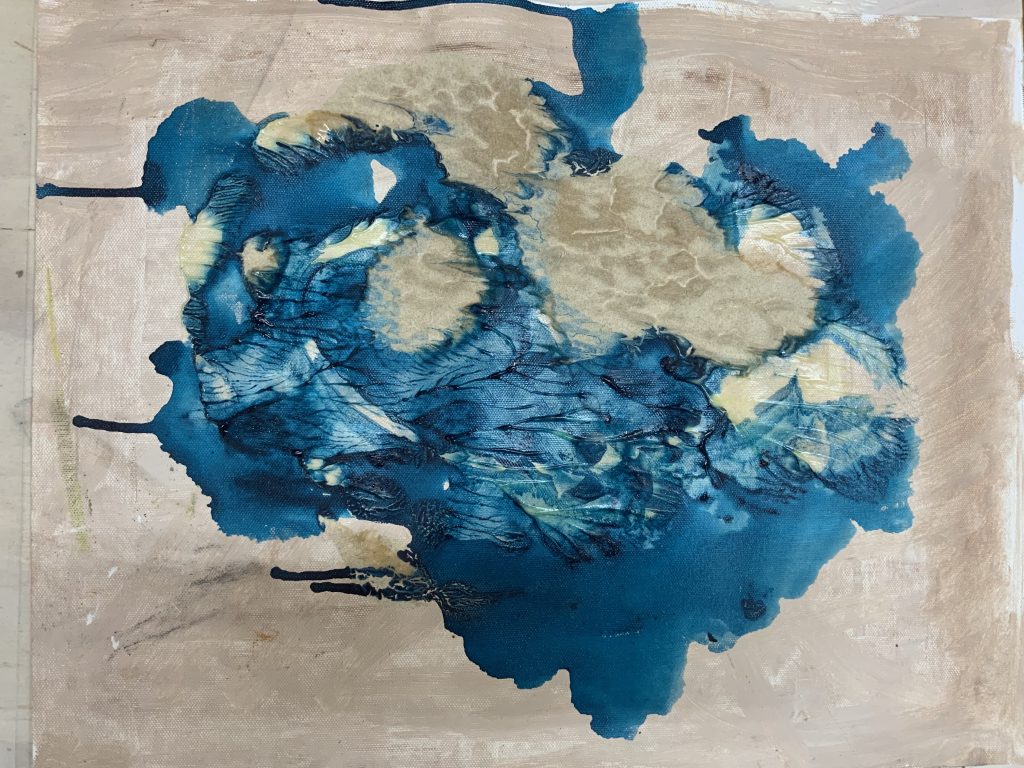
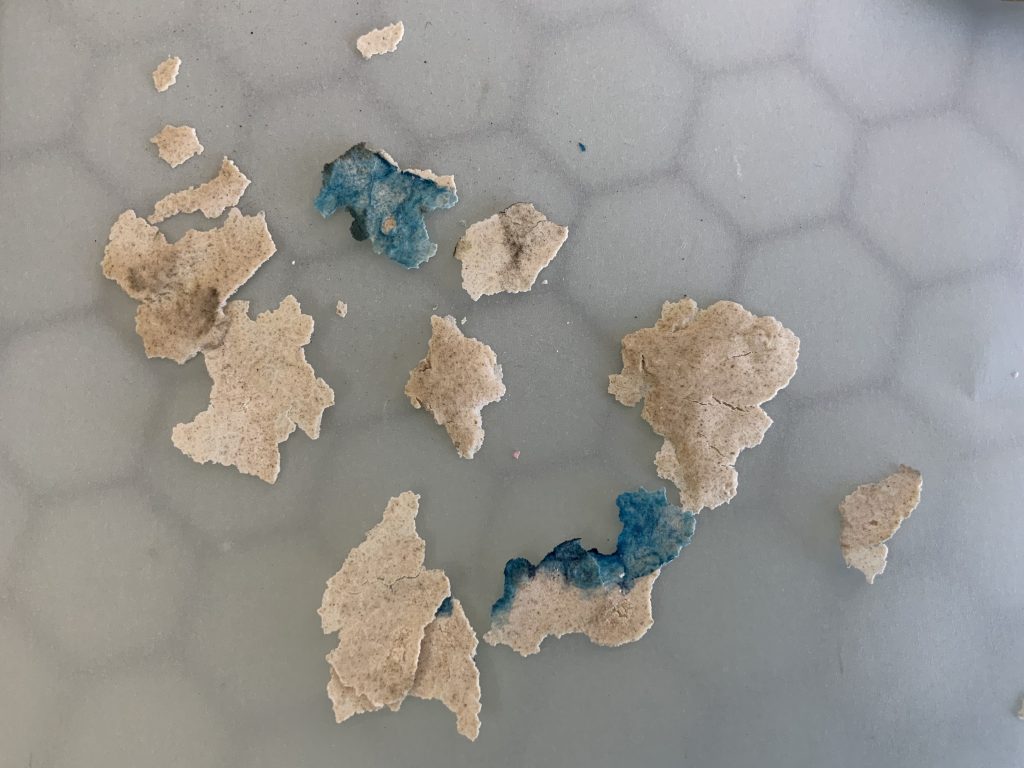
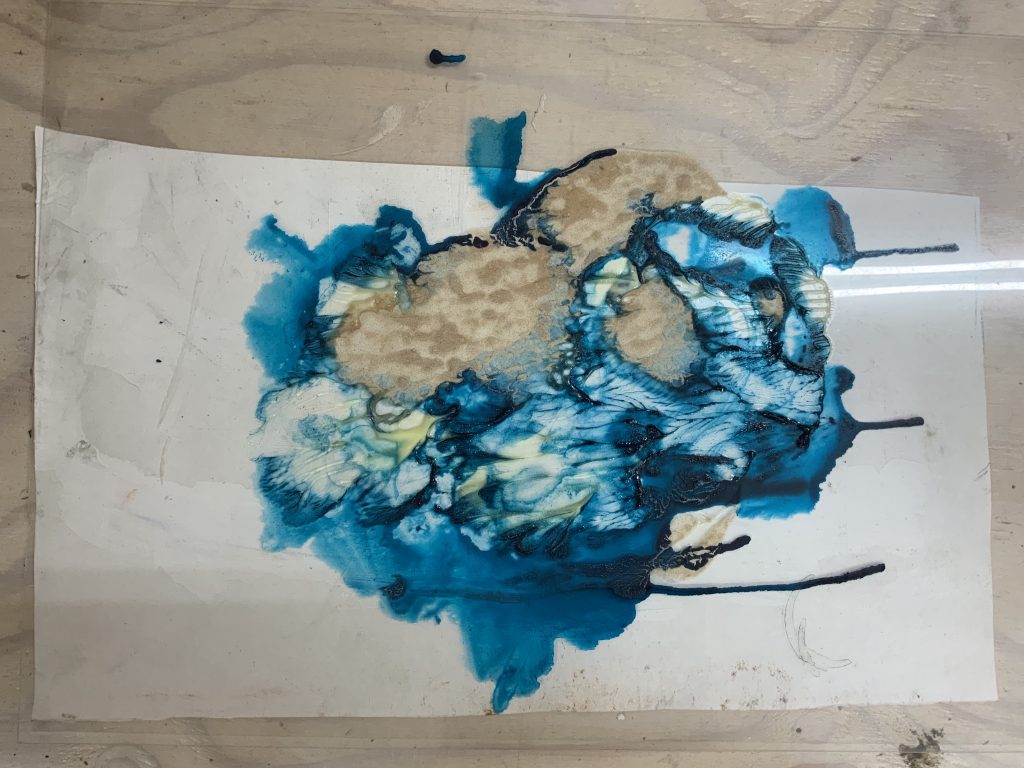
I do think the work where I used wax onto the surface opened up ideas to develop the work further. I feel I had a glimpse of how I can manipulate materials to work for me in terms of creating and preparing a canvas. I am thinking around a type of performance where the audience can assist with rubbing wax onto the surface, then charcoal and or other pigments can be added (sprayed, poured, thrown onto) – the audience can then join in to walk, any bodily movements to interact with the surface that could leave a trace of this connection, scratch or draw into it or make gestural marks on it. If the work is on the wall – the wax and pigments can be done before viewers attend and they can be asked to interact with the work.
ILLUSTRATIONS
Fig. 1 ARS (2001) Piero Manzoni, Achrome with bread rolls [bread rolls and kaolin on panel] At: https://www.jstor.org/stable/779199 (Accessed on 12 January 2022).
Fig. 2 Warhol, Andy. (1978) Oxidation Painting [urine and copper metallic pigment] At: https://www.widewalls.ch/magazine/andy-warhol-piss-paintings (Accessed on 10 January 2022)
BIBLIOGRAPHY
Mansoor, Jaleh (2001) Piero Manzoni: “We Want to Organize Disintegration” Journal article October, 95 (Winter, 2001), pp 28053 The MIT Press. At: https://www.jstor.org/stable/779199